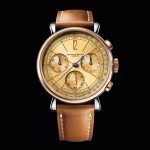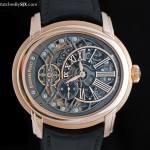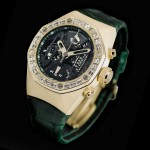Up Close: Audemars Piguet [Re]master01 Chronograph 40 mm
Brilliant quality, down to the smallest detail of the Remaster01.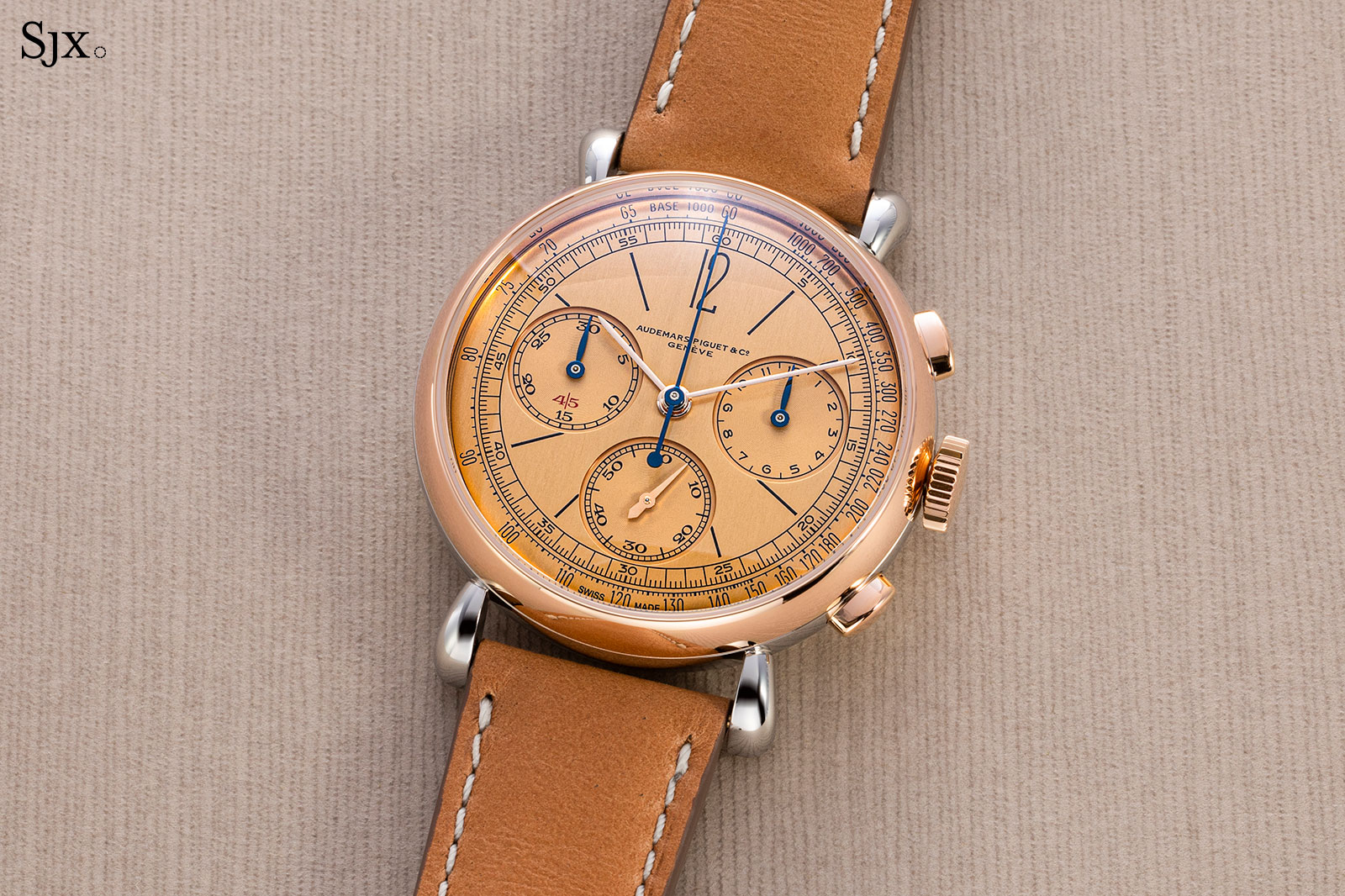
Rumours were percolating for some time that Audemars Piguet was going to unveil a vintage-inspired watch to mark the opening of its recently-finished, hairspring-shaped museum. But when the Audemars Piguet [Re]master01 Selfwinding Chronograph 40 mm was revealed, it was still surprising.
In the metal, the “remastered” watch is appealing; it looks good and the execution is impressively high quality in all aspects. The dial in particularly is sharply done, with even the tiniest details done right. And the movement inside is modern – and looks modern – but is impeccably constructed. But at the same time, the watch is a bit thick, and also expensive.
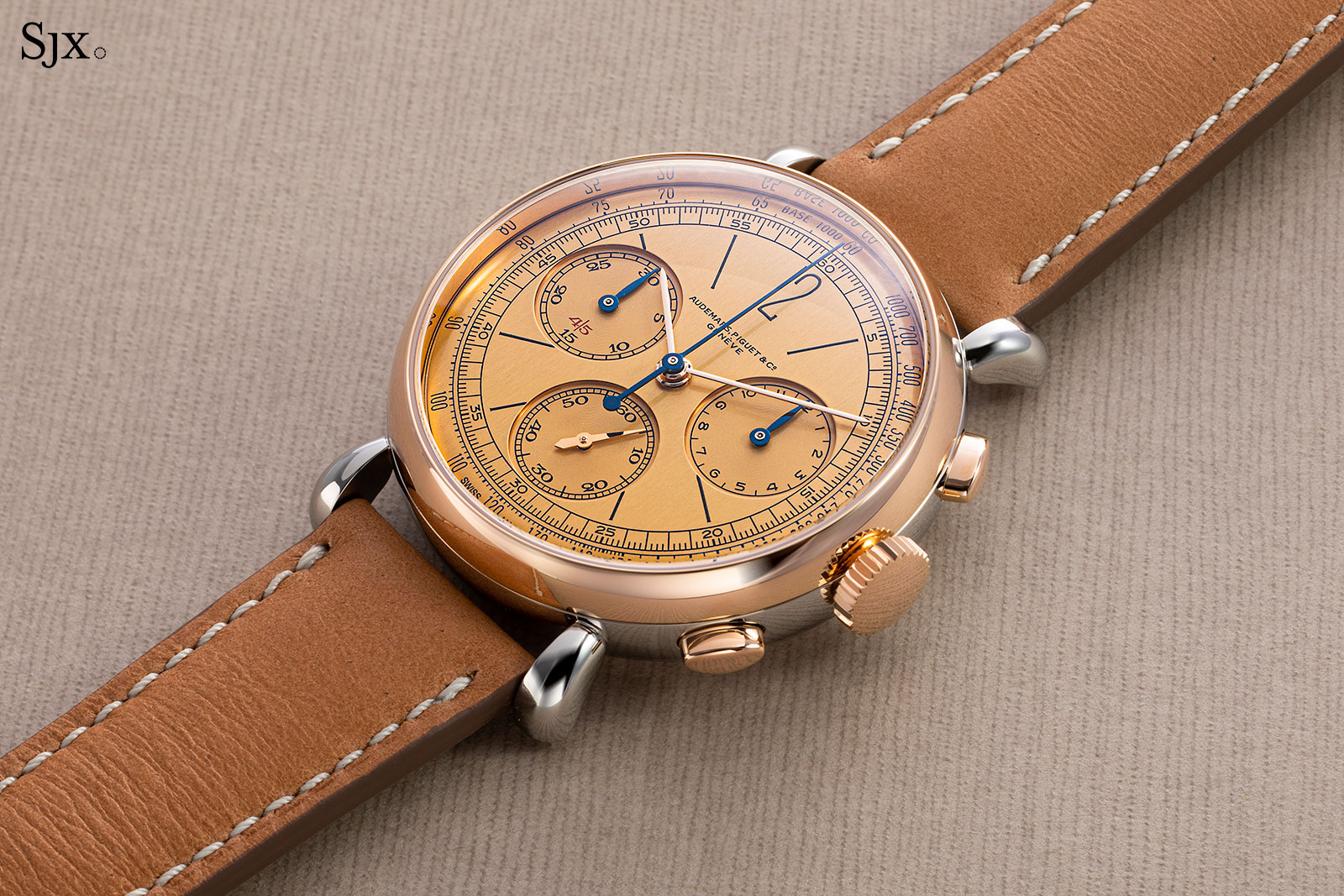
The [Re]master01 in steel and 18k pink gold
The ref. 1533
As with many reissued or “remastered” timepieces, the inspiration for the [Re]master01 is a well-known and well-documented watch: the ref. 1533, a chronograph wristwatch produced in the 1940s.
It was 36.5 mm in diameter, extra-large for the period, and a three-counter chronograph, instead of the two registers typical then. Only nine of them were made, three with two-tone, steel-and-gold cases.
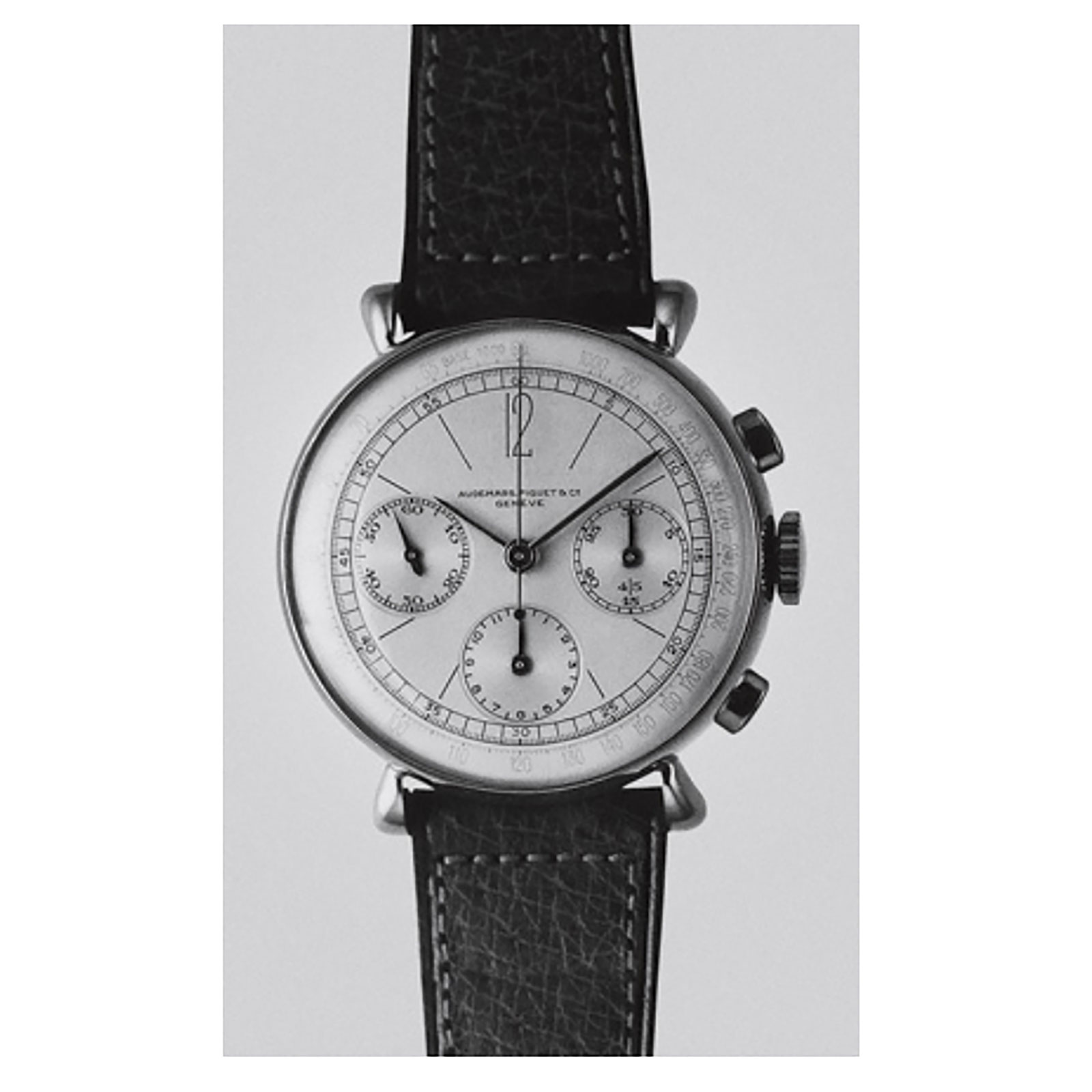
The archive photograph of the ref. 1533. Photo – Audemars Piguet
Two examples of the steel-and-gold ref. 1533 were sold in recent years at Phillips auctioneers, both setting price records for the most expensive vintage AP chronograph sold at auction. The first sold for 305,000 Swiss francs in 2015 – going to the Audemars Piguet Museum – and the second, 384,500 francs in 2018.
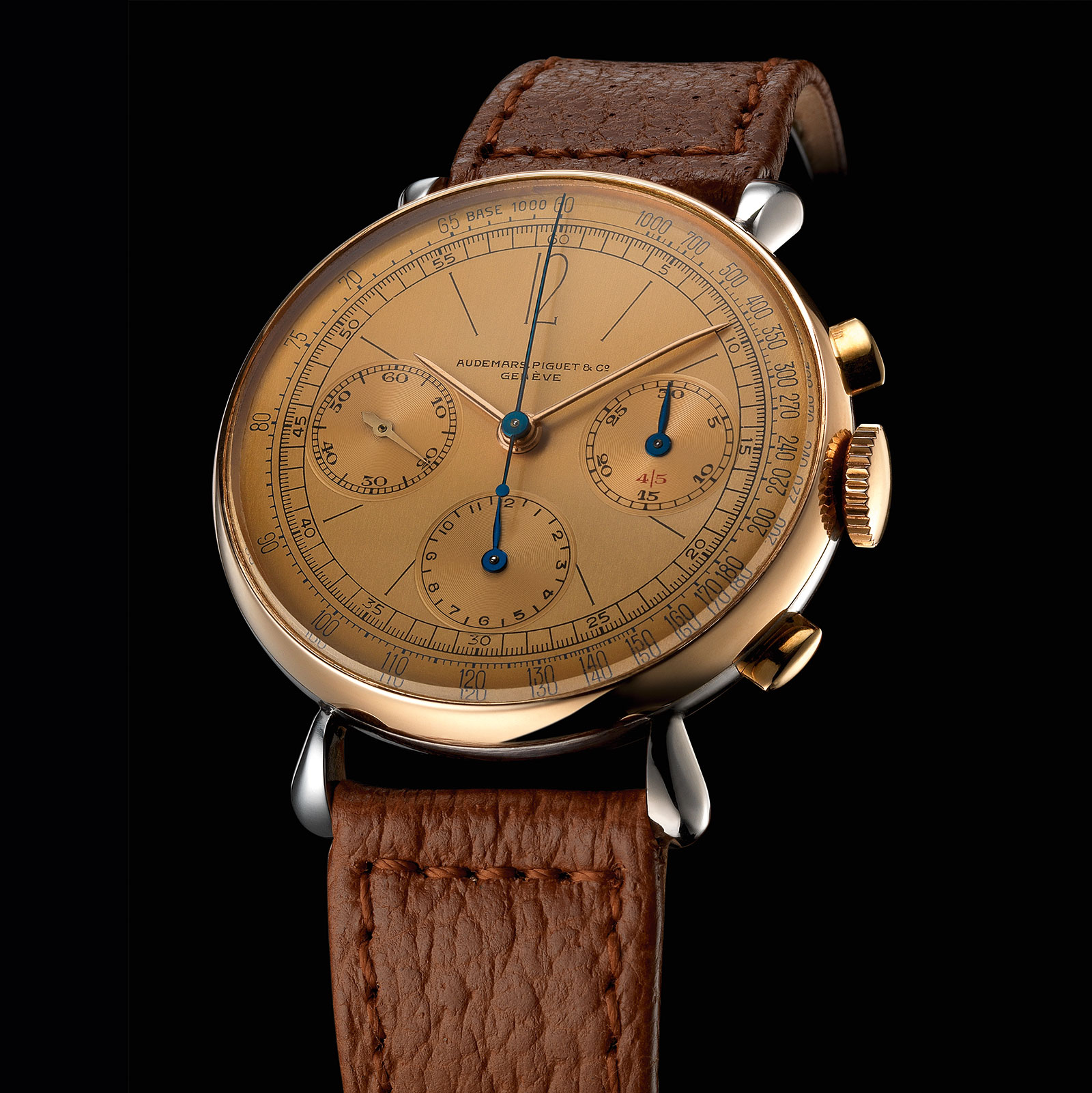
The ref. 1533 that sold for 305,000 francs in 2015. Photo – Audemars Piguet
In terms of rarity and value, the ref. 1533 is one of the most significant vintage AP chronographs, which are a rare breed in themselves. In the three decades from 1930, AP only made 307 chronograph wristwatches, many of them unique. All of that explains why the ref. 1533 was the choice for the inaugural museum watch.
Remastered
Audemars Piguet is insistent that the [Re]master01 is not a remake, reissue, or replica of a vintage watch, rather it is a “remastering” of a historical timepiece. Semantics aside, the “remastering” was done well.
The watch isn’t novel or creative, but it accomplishes exactly what it sets out to do, convey the look of the vintage original while having all of the quality and finesse of a modern watch. AP got nearly all of the vintage-inspired details just right, but the quality is distinctly 21st century, with every component exhibiting the precision and robustness only possible with modern production techniques.
The design and proportions of the watch, especially on the face, are done perfectly. Even though the movement inside is a modern calibre, the layout of the dial is almost identical to the vintage original. The chronograph registers just touch the minute track, and are far enough from the central axis, giving the dial a pleasing balance.
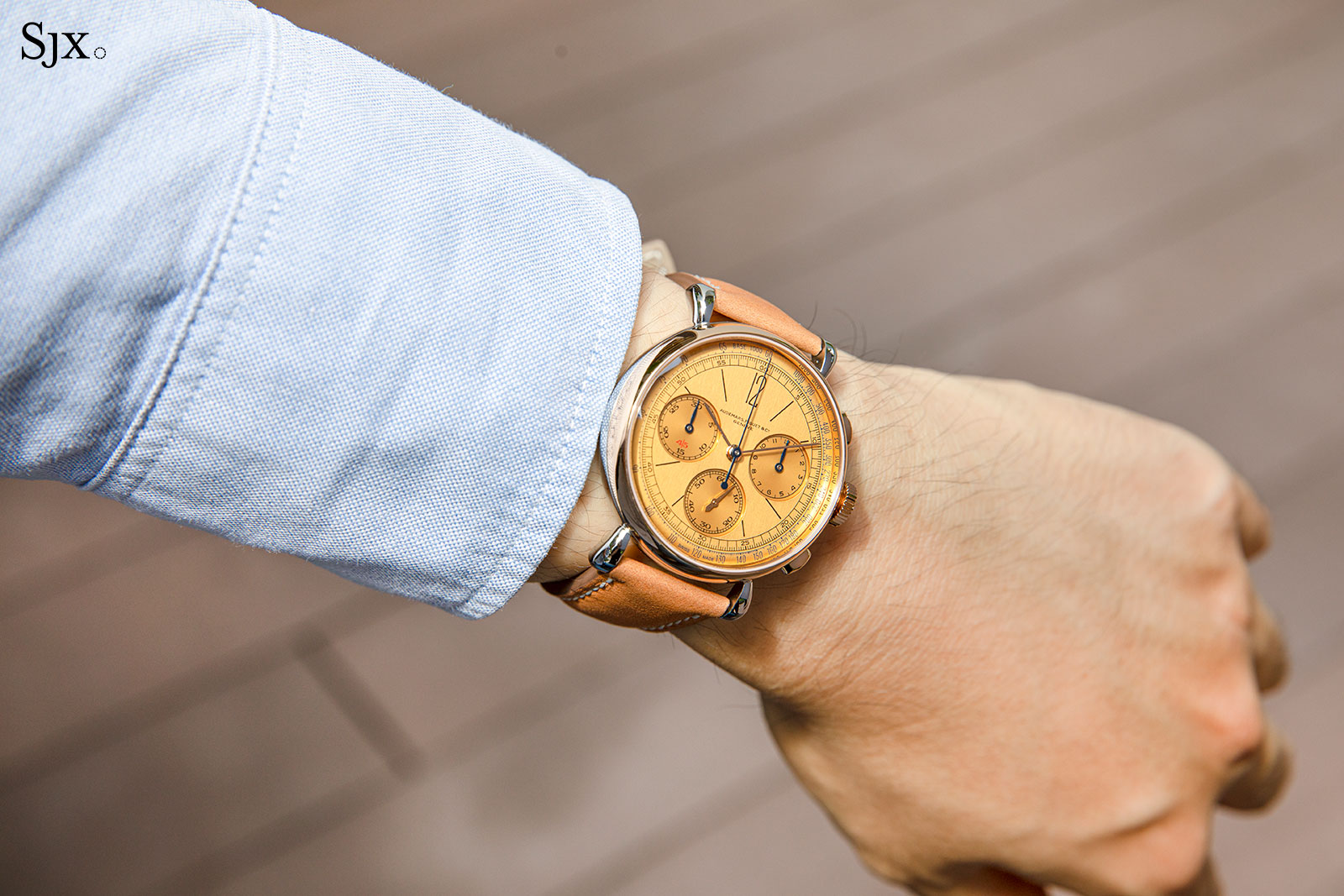
The same can be said for the case, which is 40 mm and larger than the ref. 1533, but again the proportions of the original have been maintained. Because of the excellent proportions, the watch does not look like a large watch, something that is usually the case with vintage remakes.
It is, however, a thick watch, measuring 14.6 mm high. The Rolex Daytona, in comparison, is only 12.2 mm high. And the Code 11.59 chronograph that’s equipped with a nearly identical movement, is only 12.6 mm high.
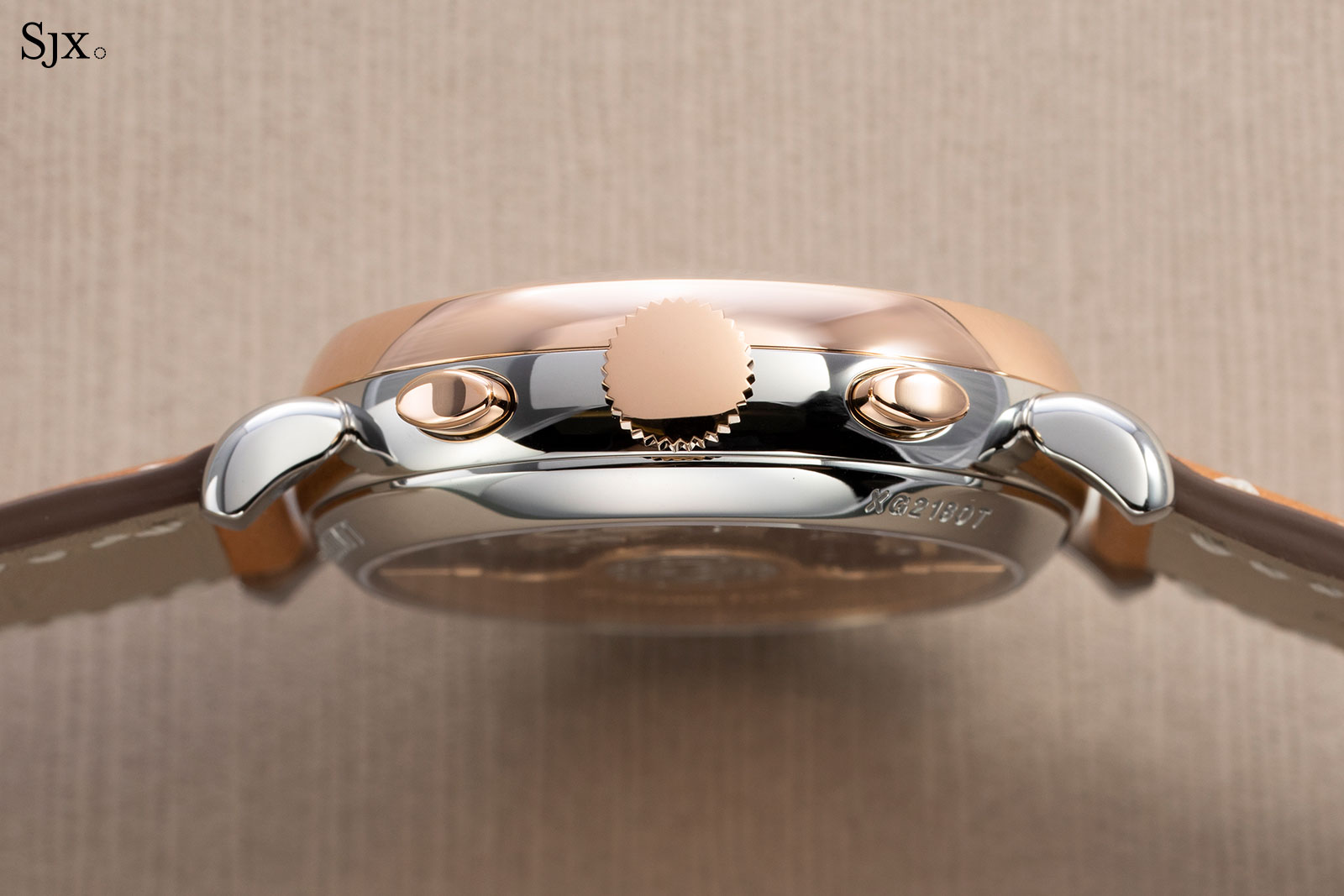
The construction of the [Re]master01 case also emphasises its thickness. Like the original, the case sides are convex, but on a thicker watch the shape accentuates the height. Add to that the bezel in a contrasting colour, and the result is a thick watch that looks the part.
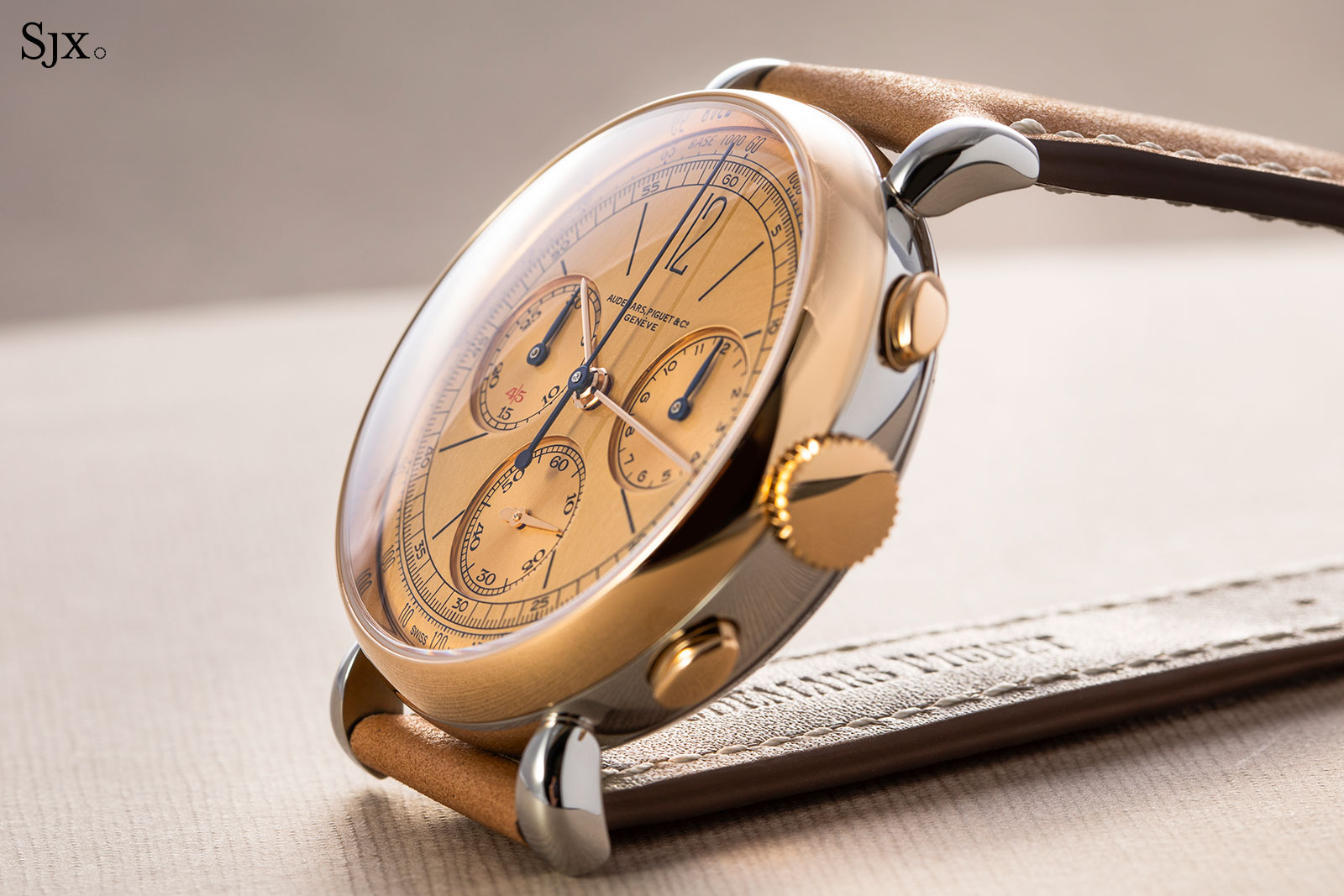
A comparison with the unfairly-maligned Code 11.59 illustrates the size of the [Re]master01. The Code 11.59 chronograph is 41 mm wide and 12.6 mm high, which means it’s wider but thinner than the [Re]Master01.
Though it’s only 1 mm larger than the [Re]master01, the Code 11.59 looks a lot larger from the front, in part due to the widely spaced lugs and narrow bezel.
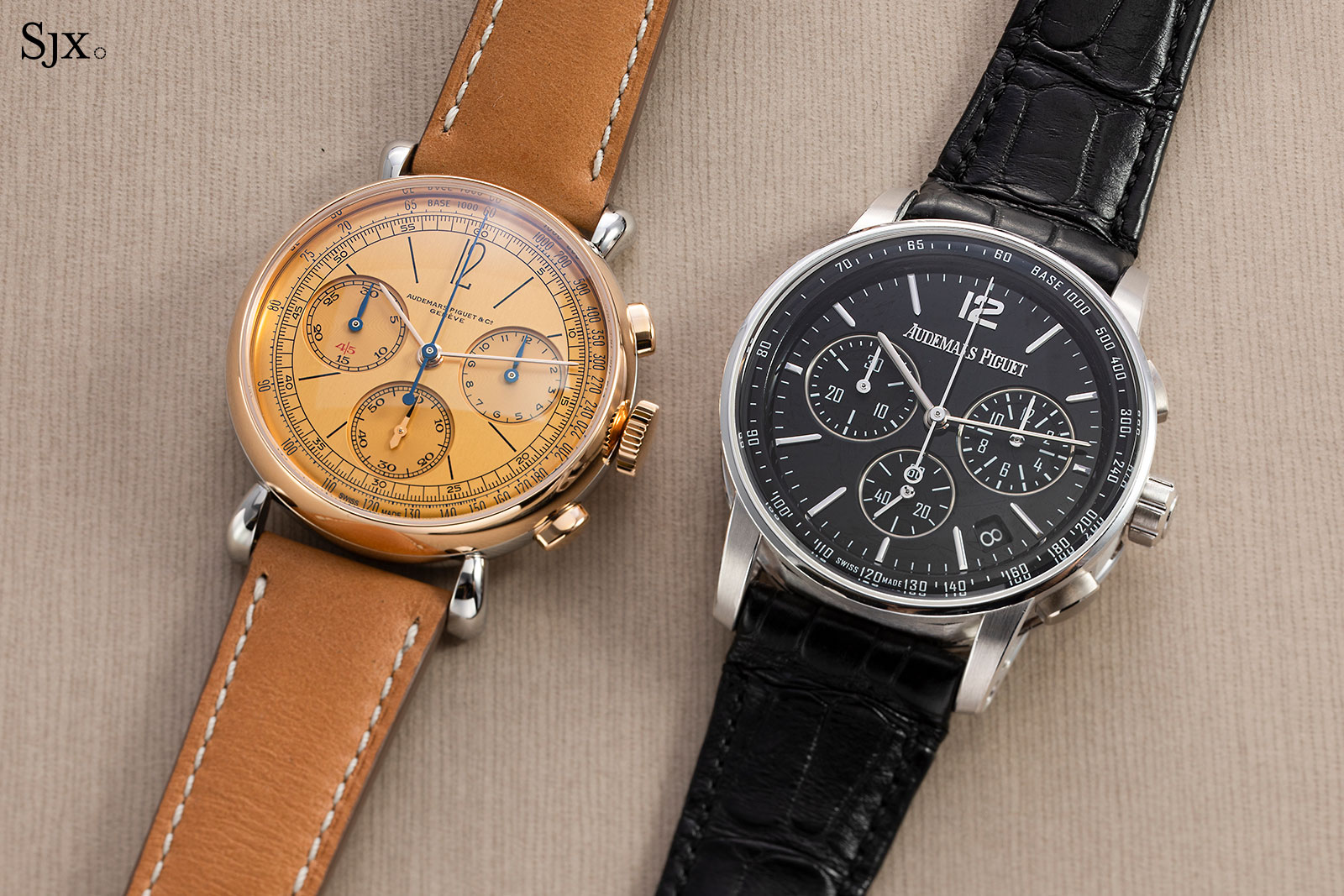
[Re]master01 at 40 mm (left), and Code 11.59 at 41 mm
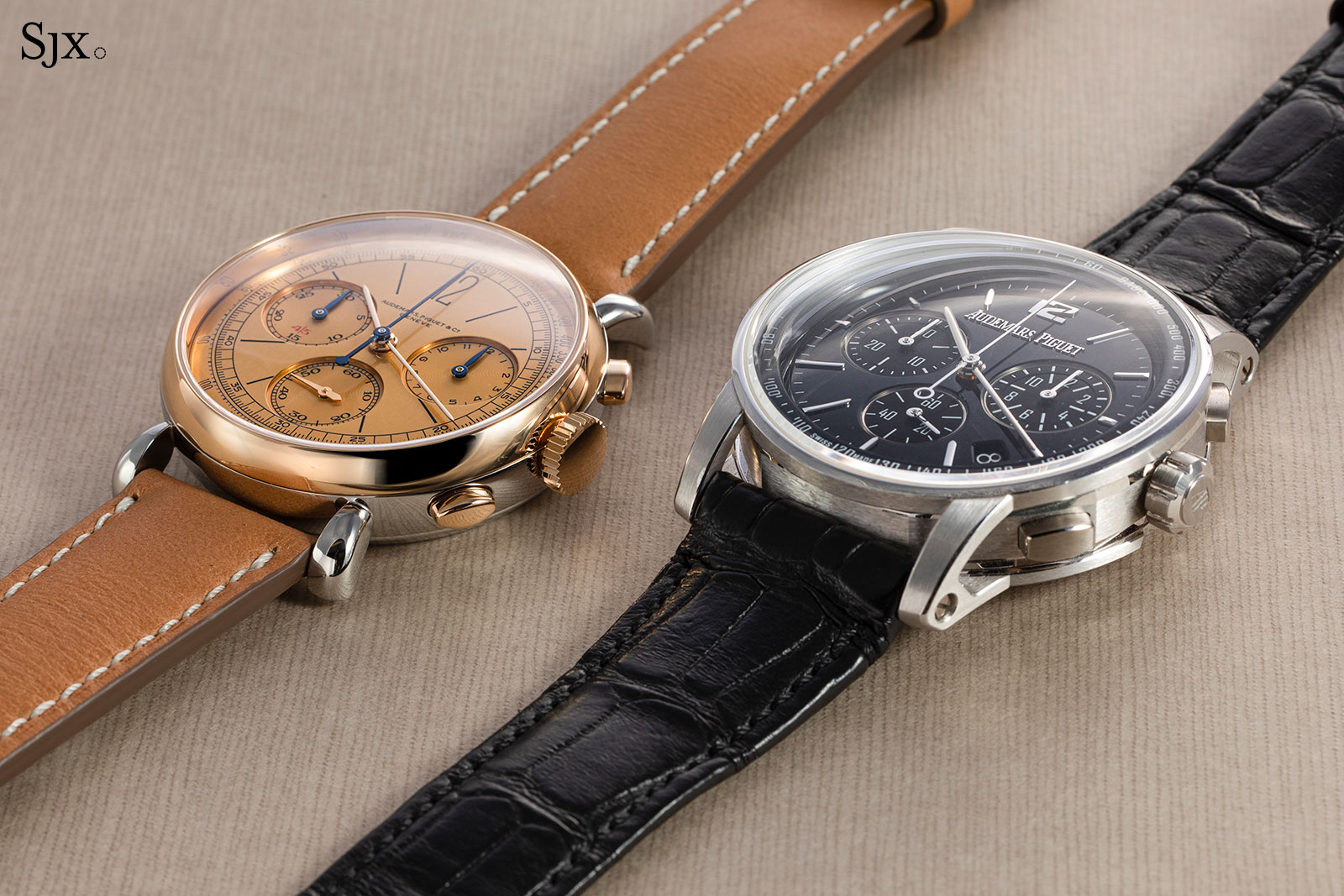
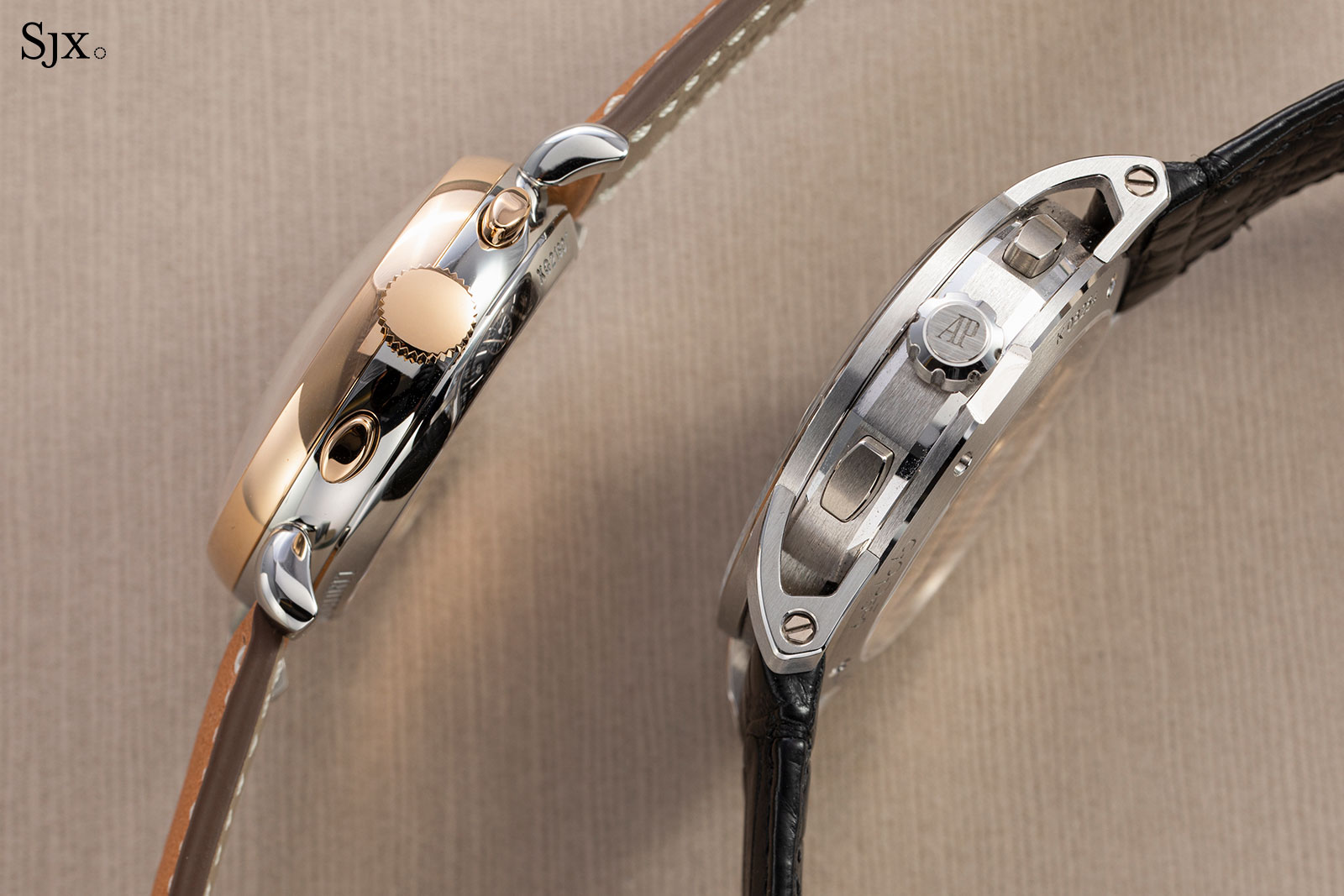
14.6 mm (left) and 12.6 mm
The upside of the thickness of the case, which equals volume, is that the [Re]master01 has the reassuring weight of a modern watch. It feels solid, well constructed, and good on the wrist. This is most apparent after having handled the vintage original at the Phillips auction preview; like all vintage watches of that era, the ref. 1533 is lightweight and definitely not robust.
The quality is not just in the feel; the case is high quality. The surface finishing, tolerances, and tactile feel is all excellent. Though the surface is uniformly finished, the mirror polishing is perfectly done. At the same time, the bezel, case, back, and pushers all fit tightly together. The crown, for instance, has the same shape as on the vintage original, but is sturdier and more finely executed.
That doesn’t come as a surprise as Audemars Piguet owns a case-making factory in Geneva, Centror, which produces watches cases for both its parent – which means the complex Royal Oak case – as well as other noted, high-end watch brands.
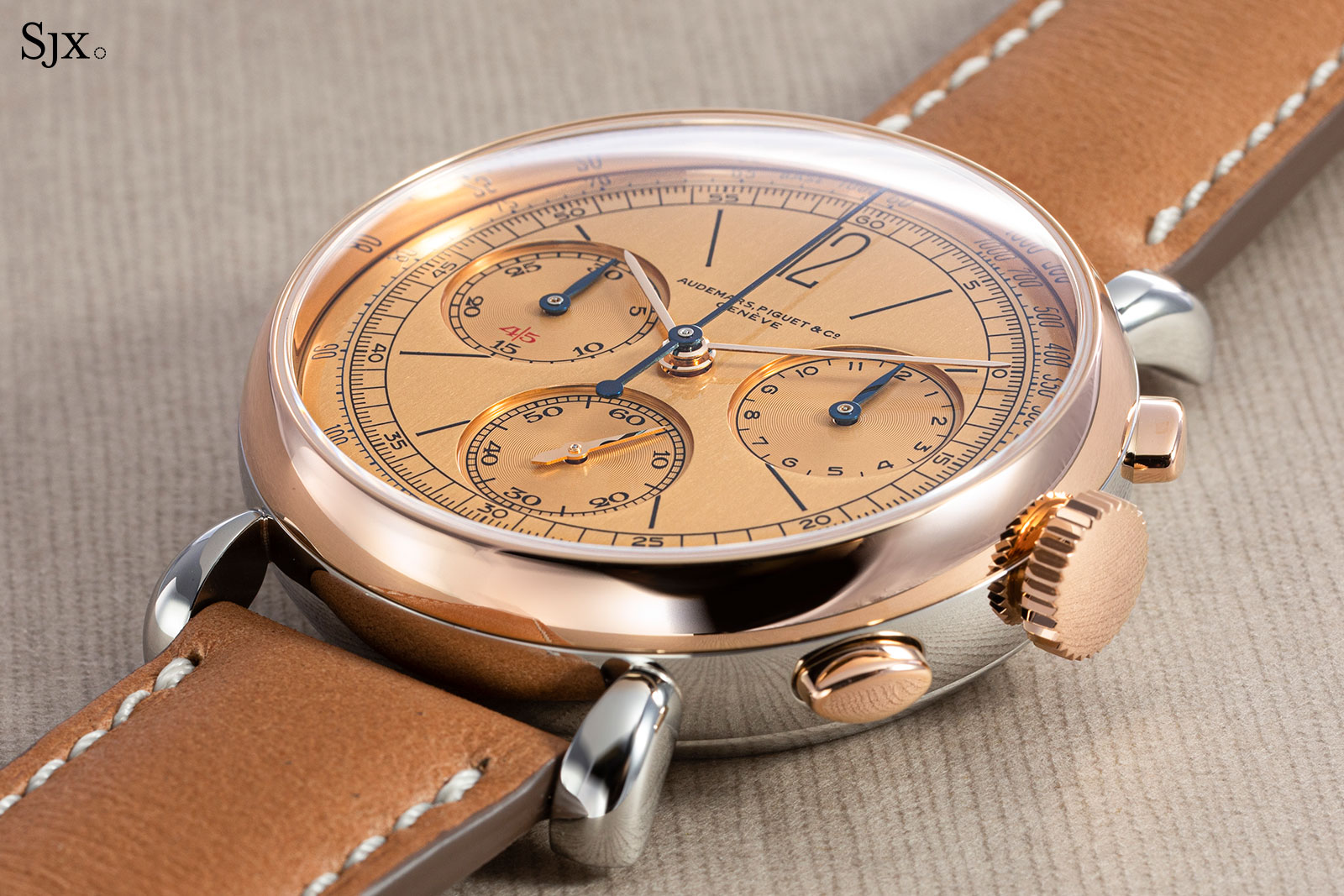
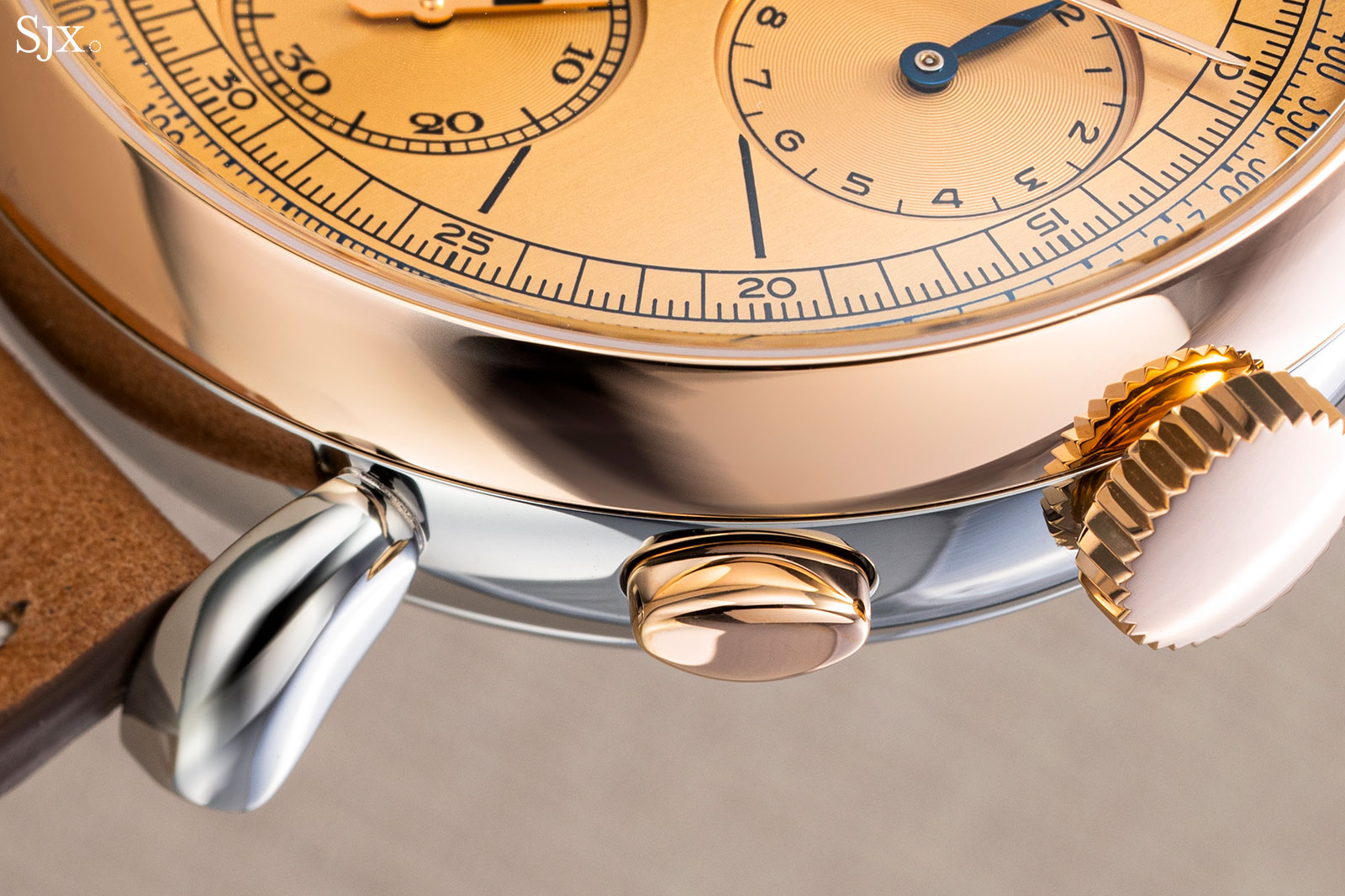
Interestingly, the case has a press-on back, rather than one secured by screws. As far as I can tell, this is the only mechanical men’s watch in the AP catalogue with a press-on back.
In terms of function and water-resistance, there is no practical difference between this and a screwed back, though press-on backs are favoured for their thinness and streamlined aesthetics. The small size of the [Re]master01 watch case relative to the movement inside is most likely the reason behind the case back construction.
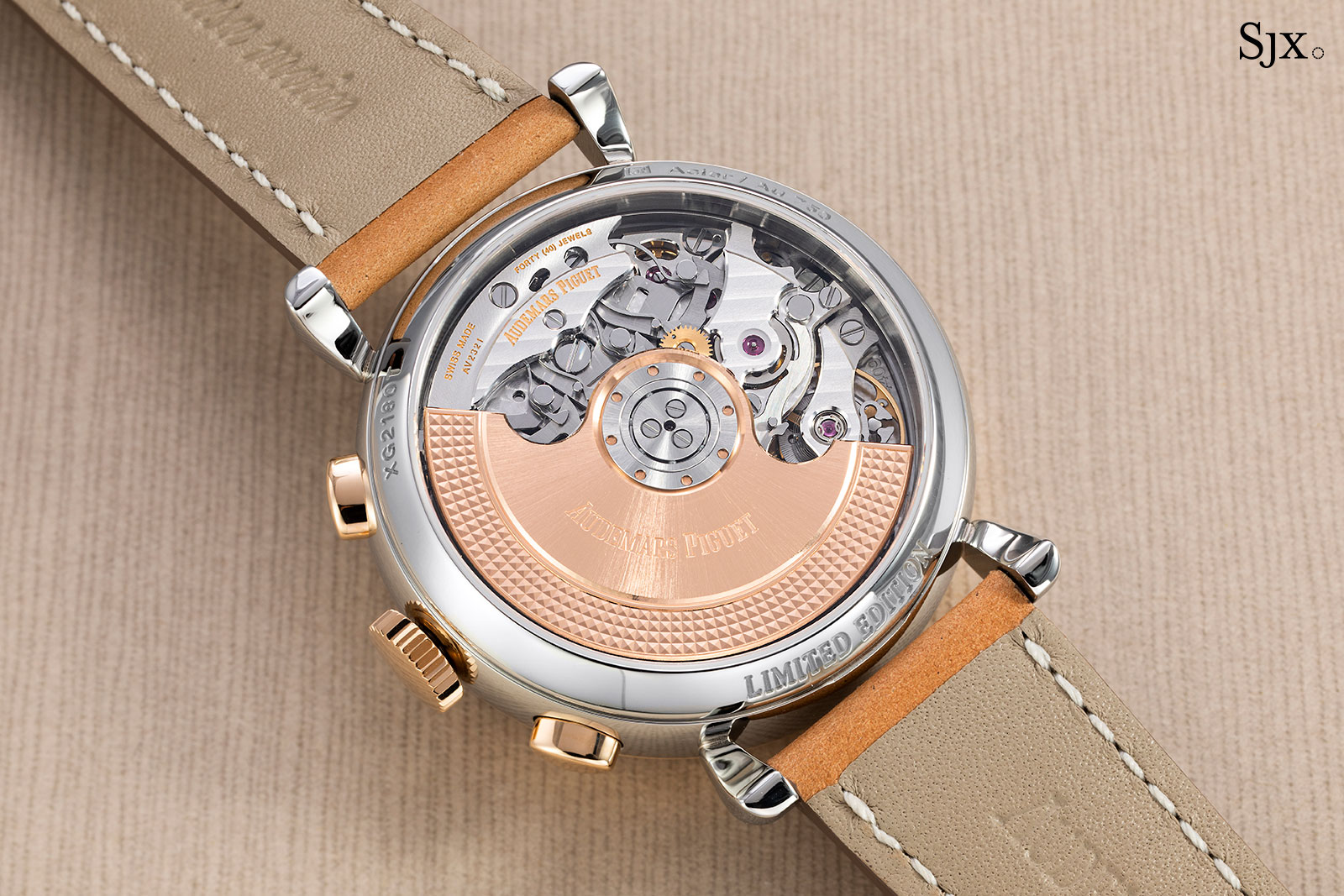
Rosy gilt
The dial is particularly well done, both in terms of quality and details. In fact, it is well done enough it brings to mind a perfectly-executed redial – a massive no-no for a vintage original but high praise here.
Though the dial appeared champagne in the stock images, it is more like a rosé champagne in the metal, and works well with the pink gold bits of the case. Like the vintage originals, it is finished with a fine vertical brushing and then covered with a clear protective lacquer, which has been lost with time on the vintage examples but is obvious here, giving the dial a slight gloss.
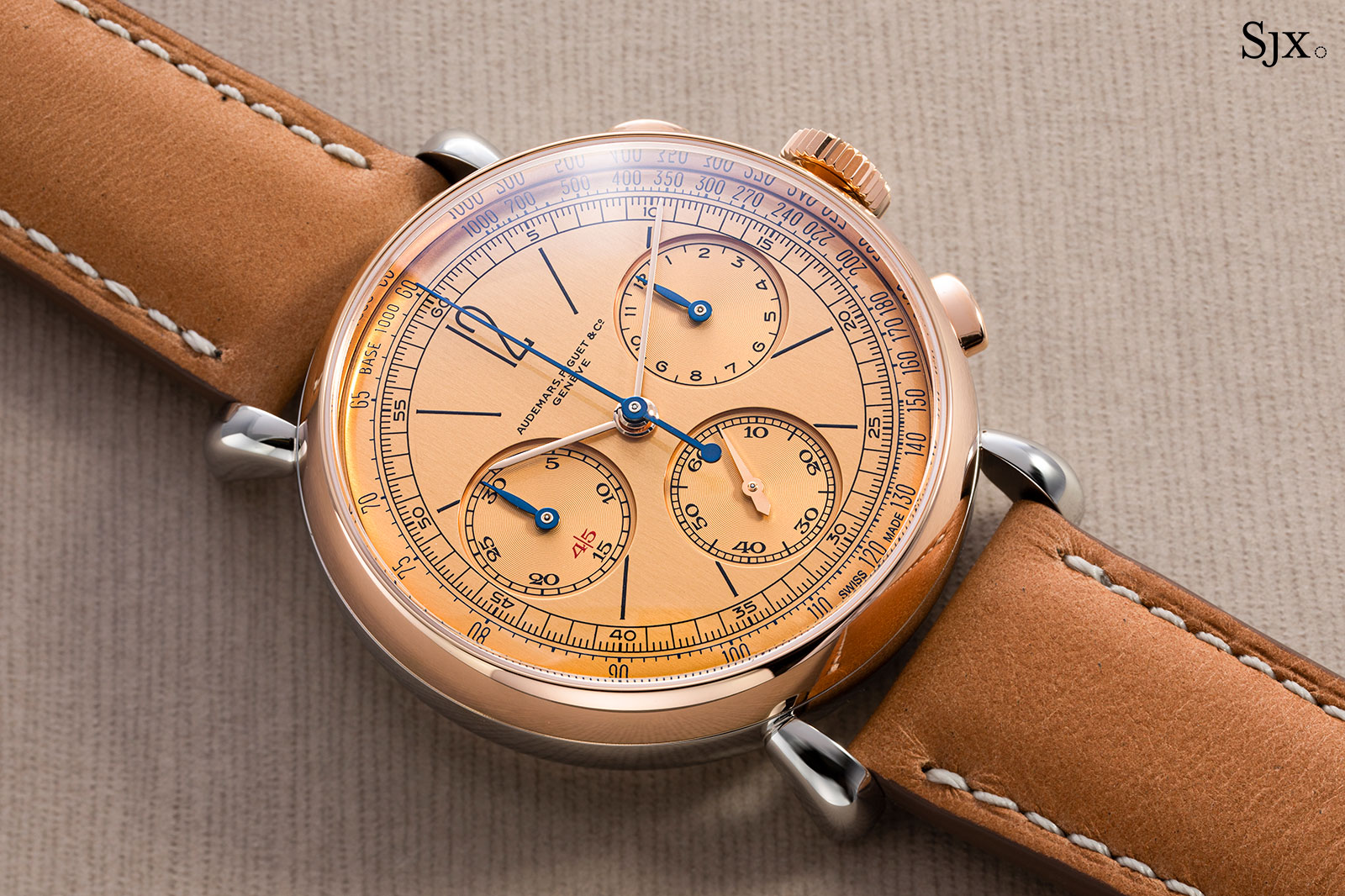
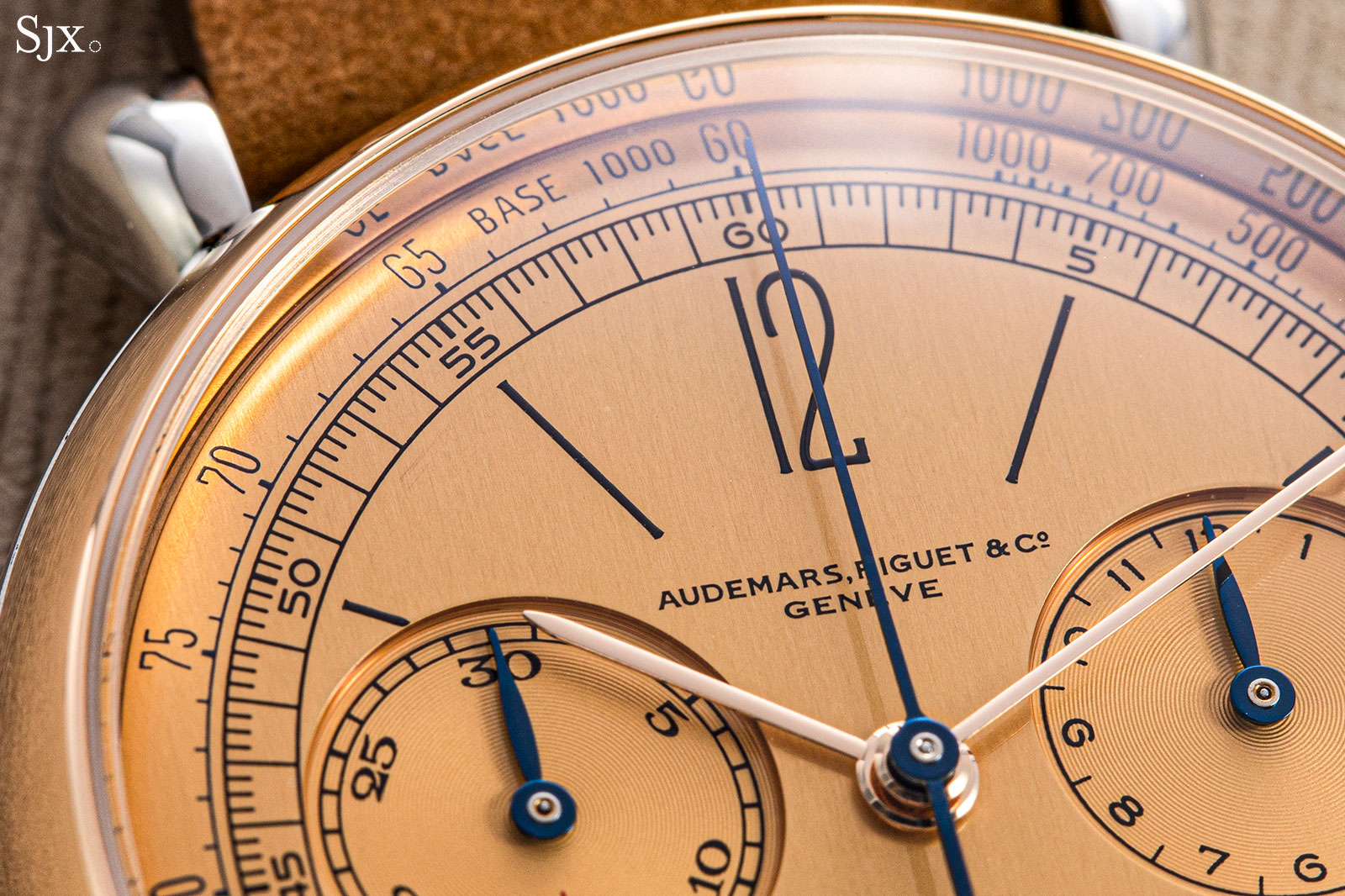
All of the key details of the original have been sharply reproduced on the remake, ranging from the retro AP logo that includes “Genève”, because the firm had a workshop in the city until the 1970s.
Another is the “45” on the minute counter, a feature to mark half-time in football matches. It was found on most vintage AP chronographs because its chairman until 1975, Jacques-Louis Audemars, was a football fan.
Although the arrangement of the chronograph counters reflect the modern movement inside, the hands are true to the original in purpose. Chronograph hands are blued steel, while hands that tell the time are in pink gold gilt.
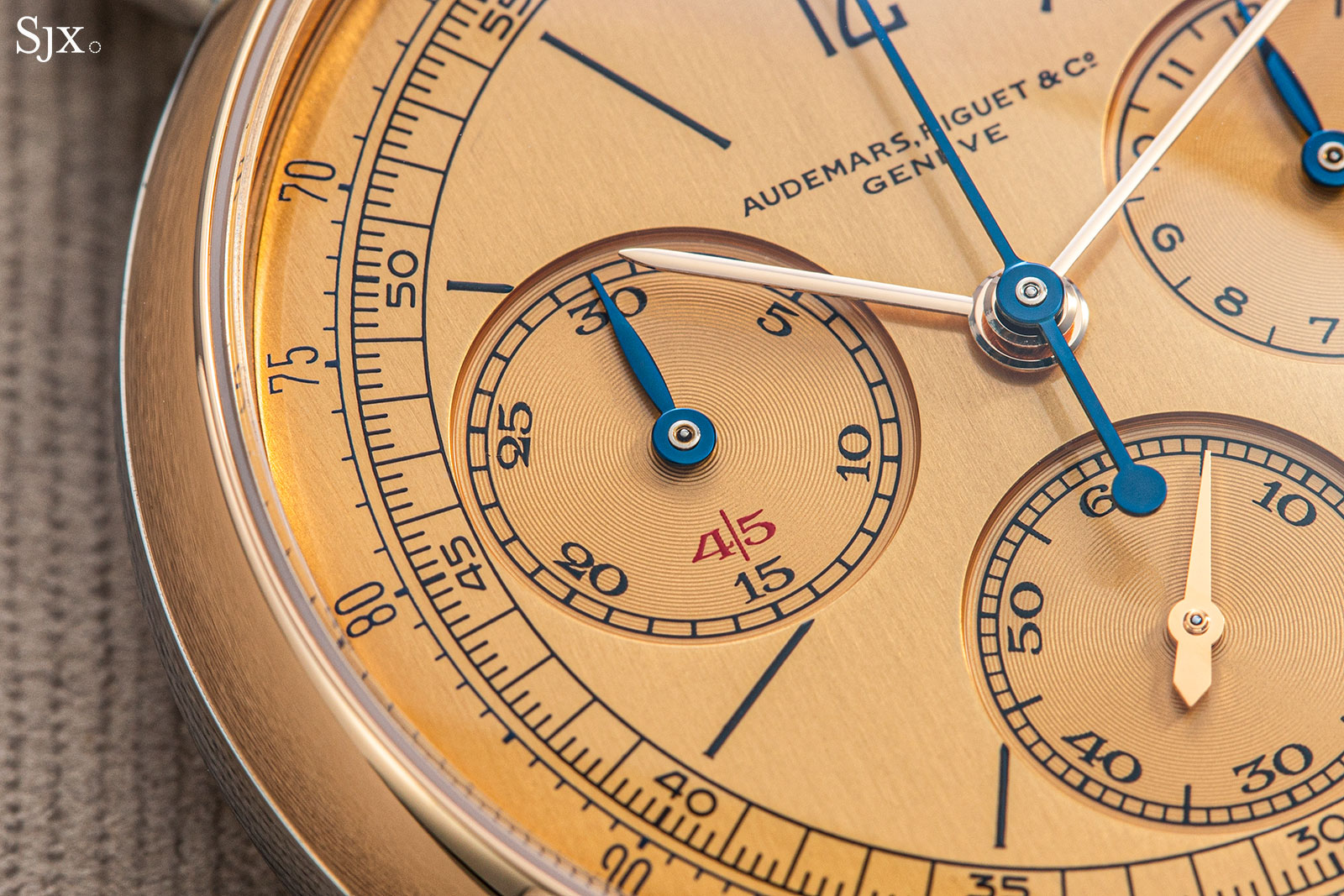
But more important than transferring the vintage elements onto the new watch is how it was done. AP passes the test; everything was done with unwavering attention to detail.
Especially noteworthy is the typography used for all the markings on the dial. There tiny serifs are there, and the sixes are “open”. Even the hour markers have tiny serifs, exactly as they were on all watch dials back in the day.
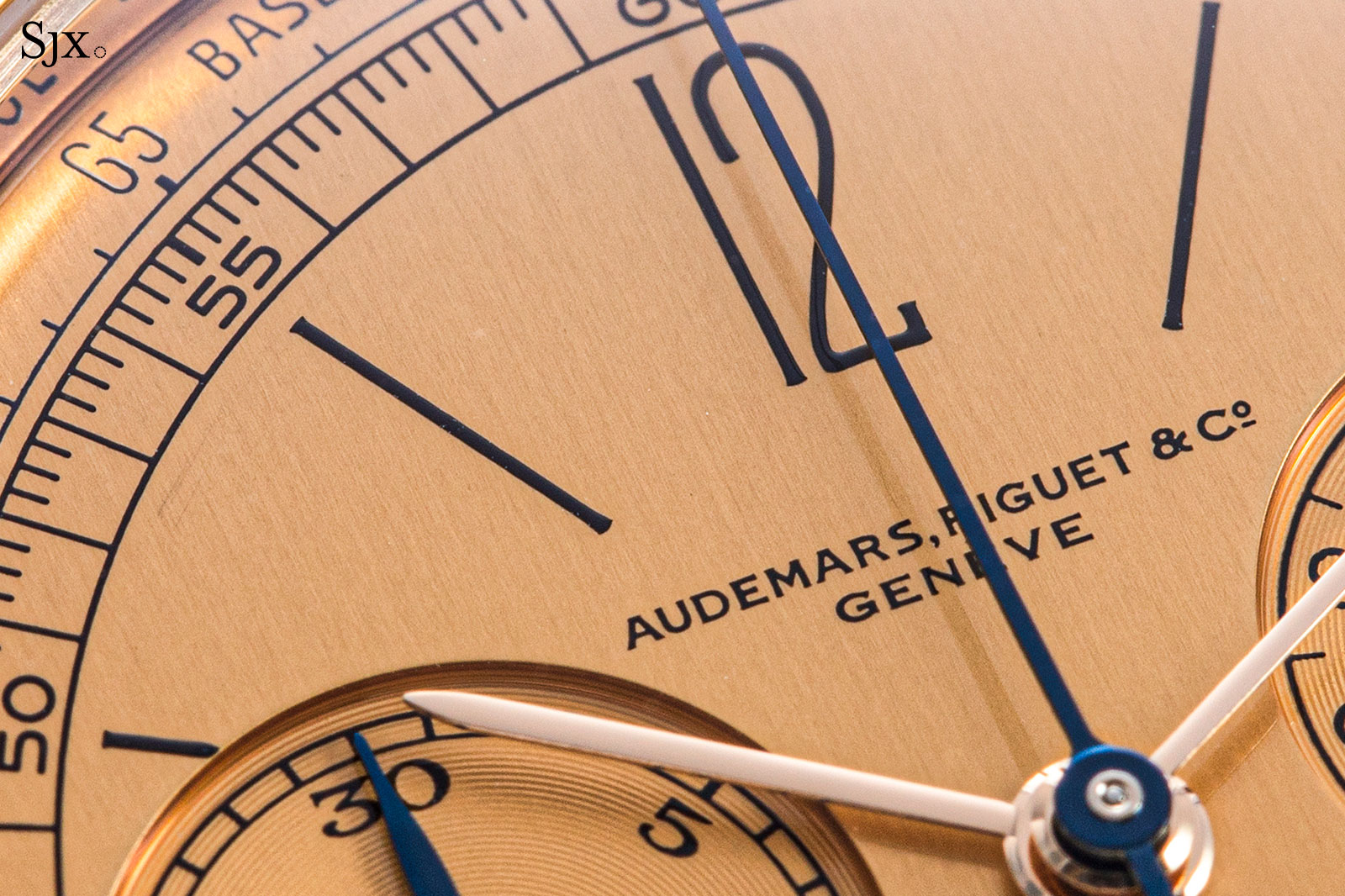
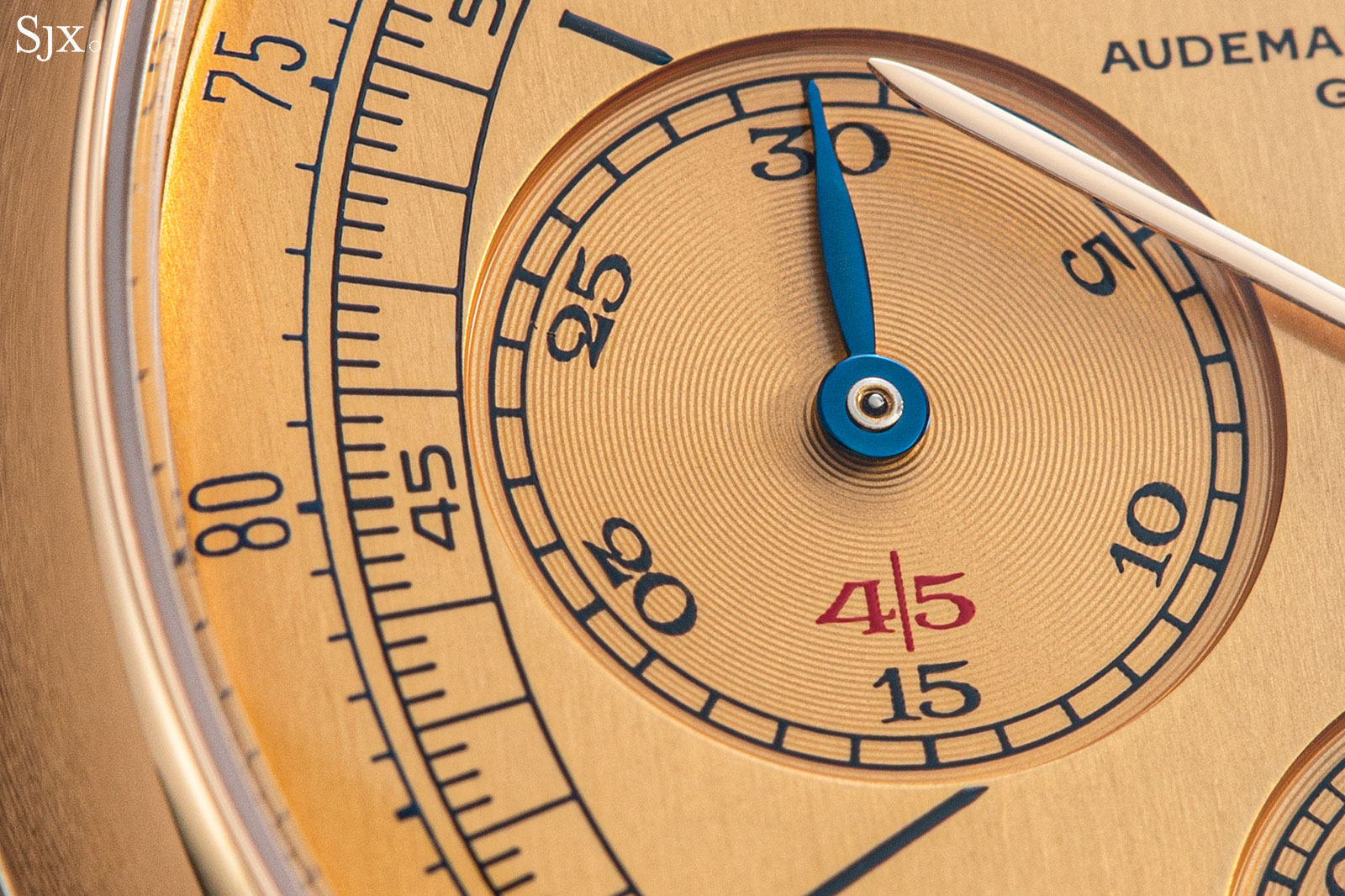
At the same time, the dial is obviously different from the vintage original – besides being larger, the colour is brighter, glossier, and well, newer. But it is also changed more subtly, including being quite a lot thicker.
The thickness of the dial is evident in the recessed sub-dials that have noticeably high walls, whereas on the original the sub-dials were lightly stamped into the dial. One reason for the deeper-set registers is the stamped concentric guilloche, or azurage, on the sub-dials. The dial quality is evident on the sub-dials; despite the stamped pattern, all of the markings are neat with no visible fuzzy edges.
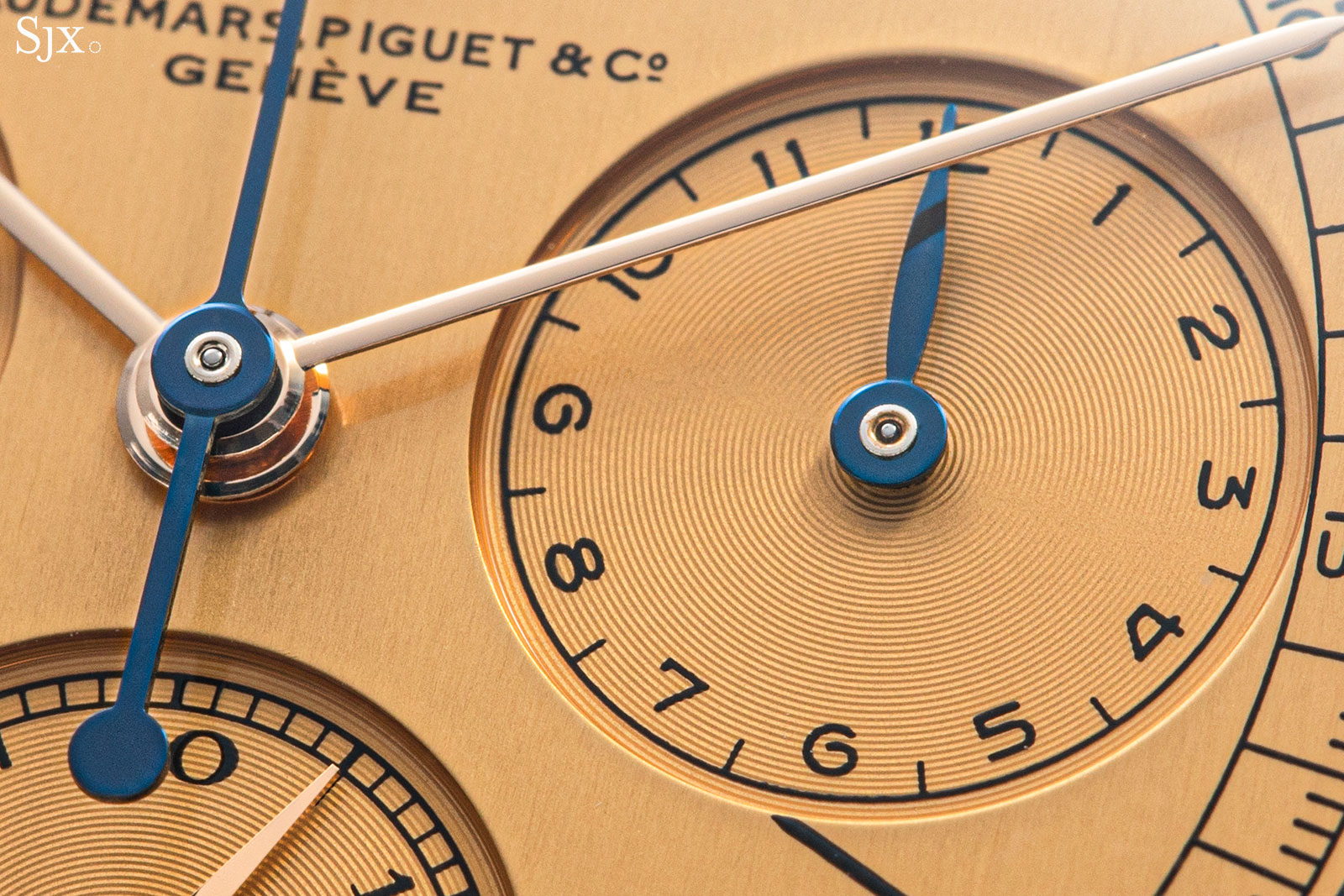
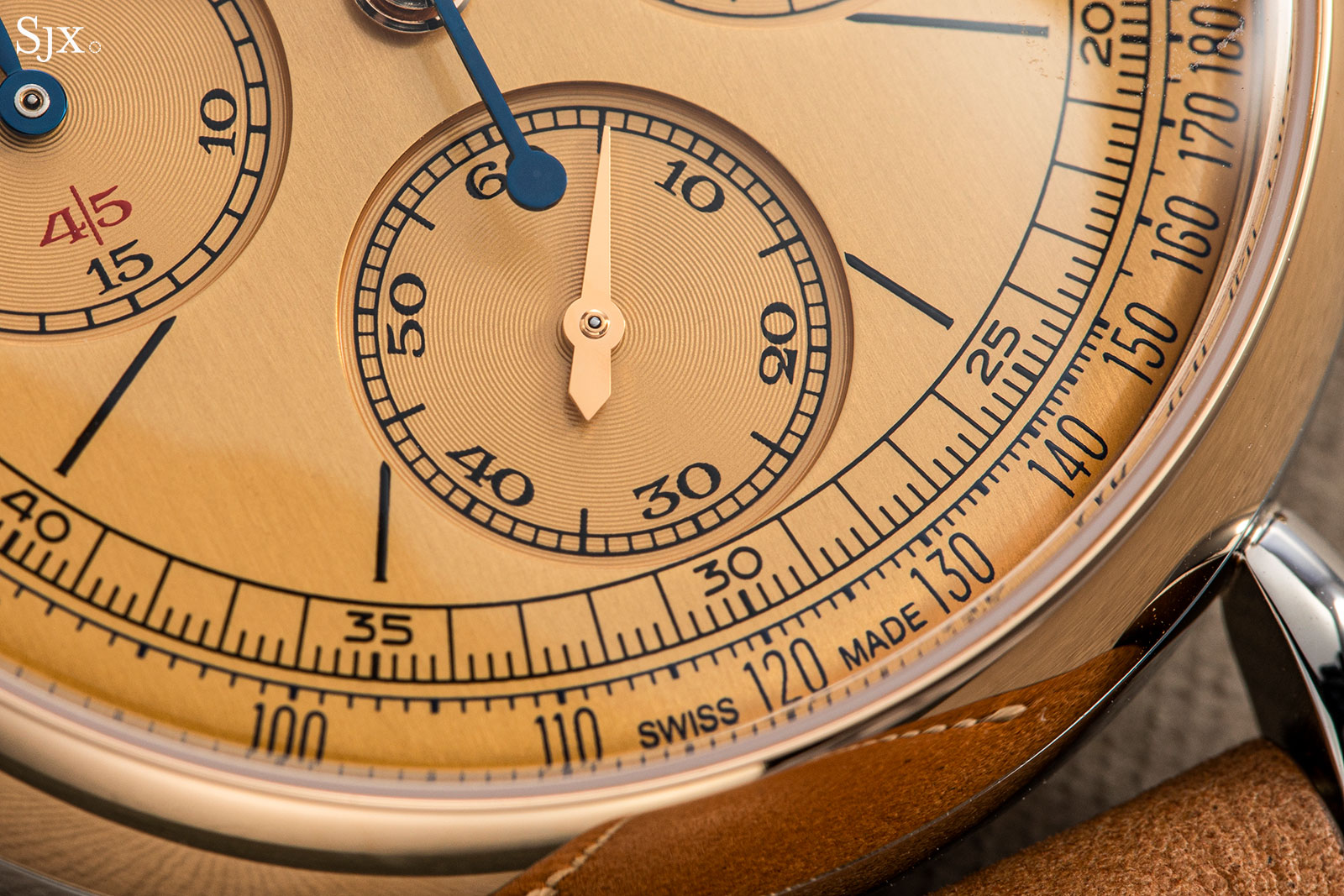
The movement
One reason behind the case height is the cal. 4409, an automatic movement with a flyback chronograph function. It’s essentially the same calibre as the cal. 4401 found in the Code 11.59 chronograph, but built without the date display. Because the Code 11.59 was met with unwarranted aversion, the movement was pretty much overlooked – which is a shame because it is a good one.
When viewed from the back, the cal. 4409 clearly fills up the case. It’s a large movement, even by modern standards, at 32 mm wide and 6.82 mm thick, but the size is the result of its solid construction. Importantly, the size reason the dial has good proportions; a smaller movement would mean sub-dials clustered uncomfortably around the centre of the dial.
Naturally, a hand-wound movement would have been more in keeping with the spirit of the original, while also allowing the watch to be slightly thinner. But I can imagine AP has many well-founded reasons – that make sense from a corporate perspective but are less clear to the enthusiast – for using an automatic movement, including consistency in the product line as well as the goal of “remastering” rather than remaking.
But it is what it is, and the cal. 4409 is an excellent movement when assessed in terms of construction, features, and to a lesser extent, finishing.
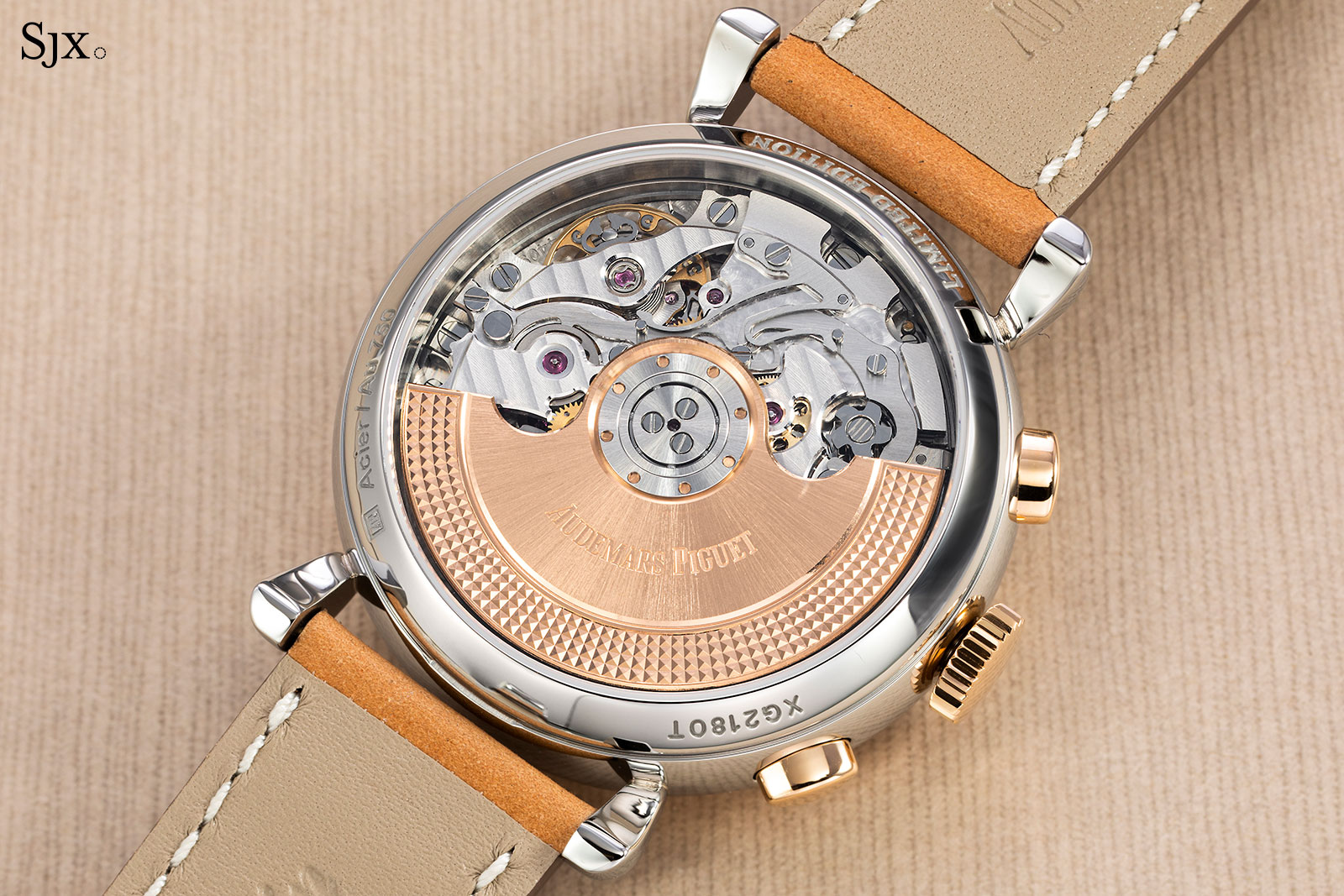
The cal. 4409
The movement is equipped with the typical characteristics of a modern, high-end chronograph, namely a column wheel and vertical clutch, which are commonplace.
But it is a sophisticated movement that also incorporates less widely seen features, like individual reset hammers for each register (instead of a single, elongated hammer for all three that is widely used today), as well as a free-sprung, adjustable mass balance. Both add a bit of refinement while also improving the long-term serviceability of the movement, while being more complex to assemble.
Visually, several elements of the movement stand out, most obviously the robust construction. Individual parts of the movement have obviously been built for stability and longevity.
The balance wheel, for instance is secured by a large, full bridge with an unusually large, pincer-shaped stud carrier. And all of the chronograph levers and springs are broad, which also helps keep them flat to reduce the vertical space occupied by the chronograph mechanism.
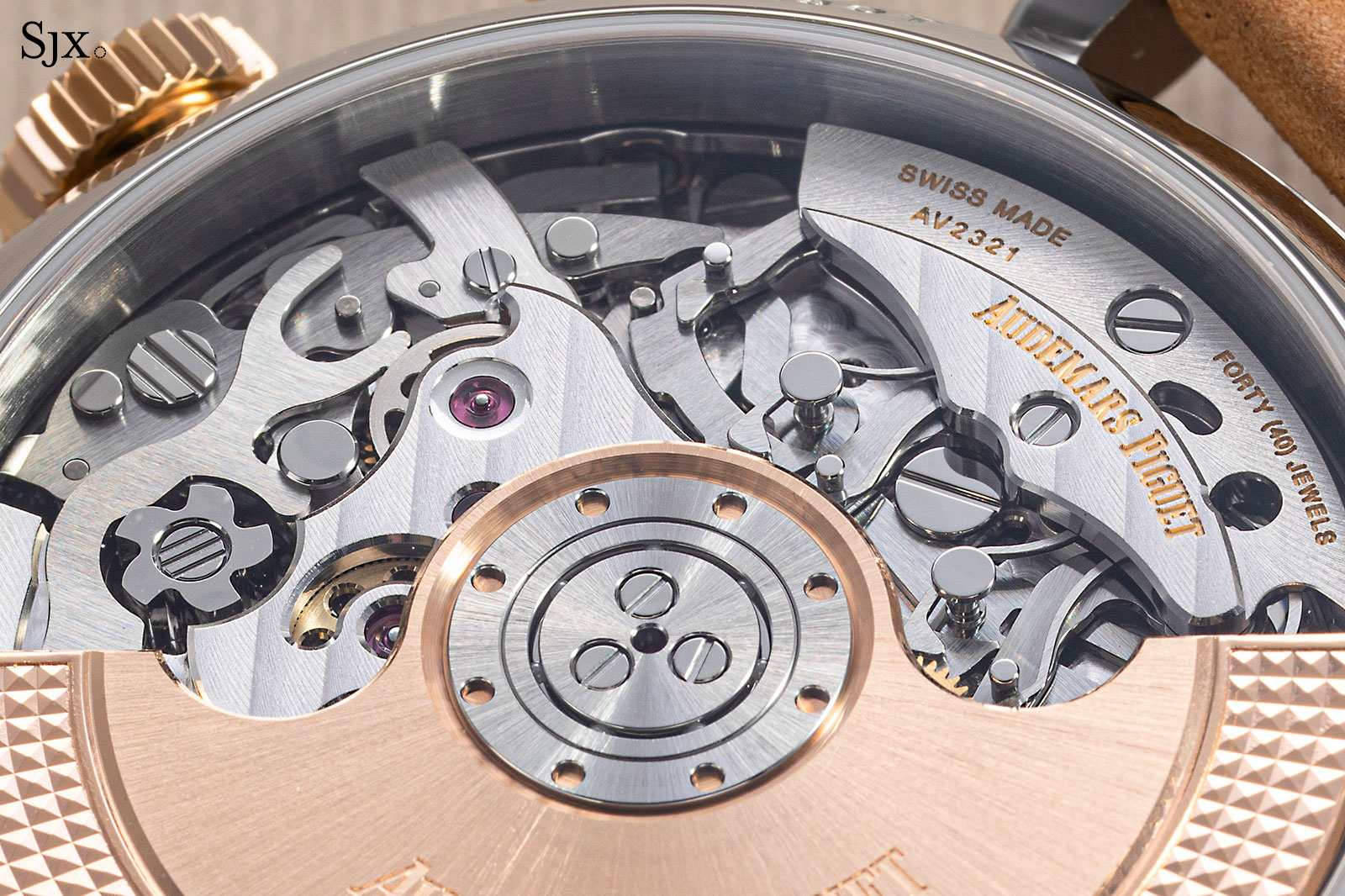
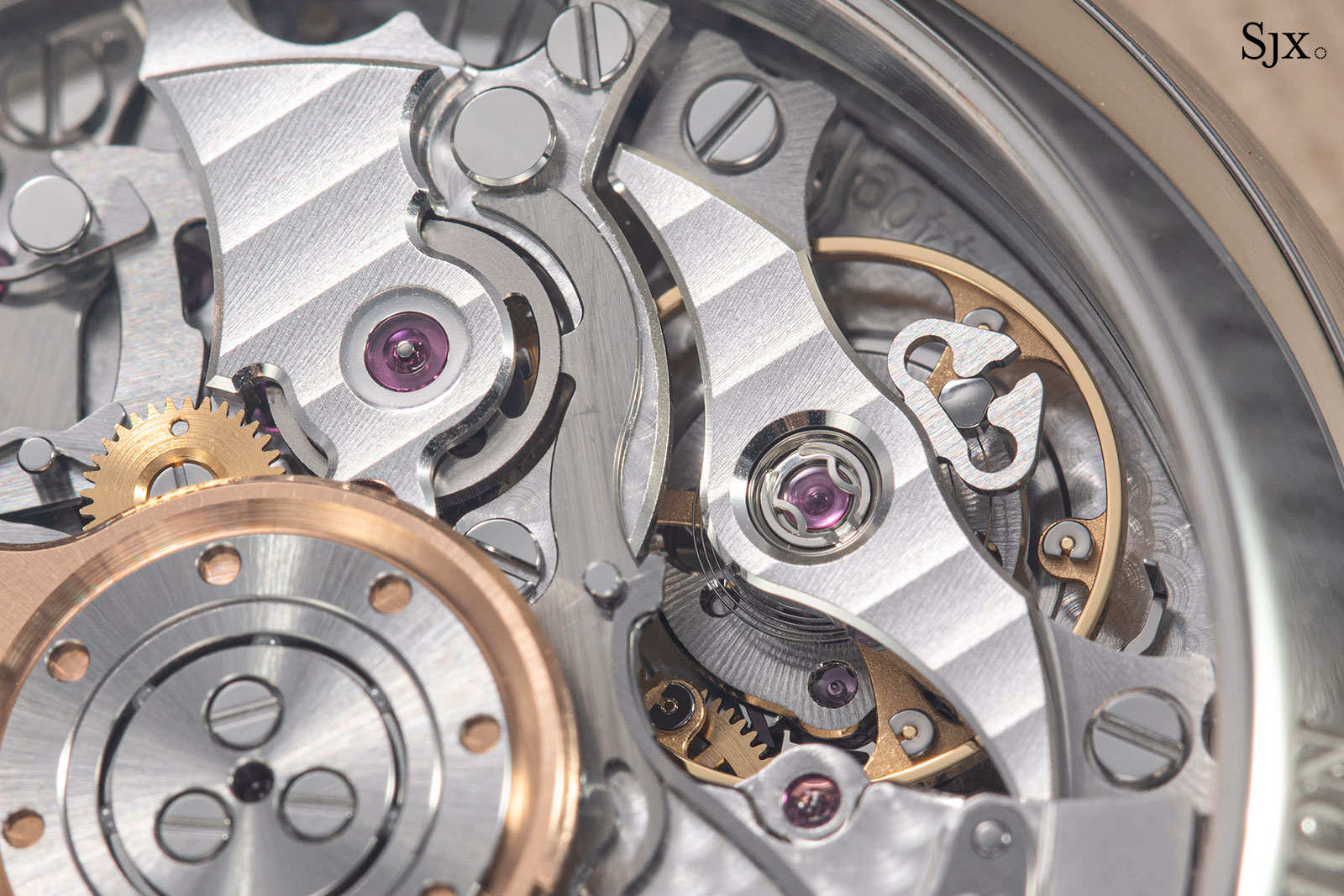
The balance bridge with its unusual stud carrier on the right
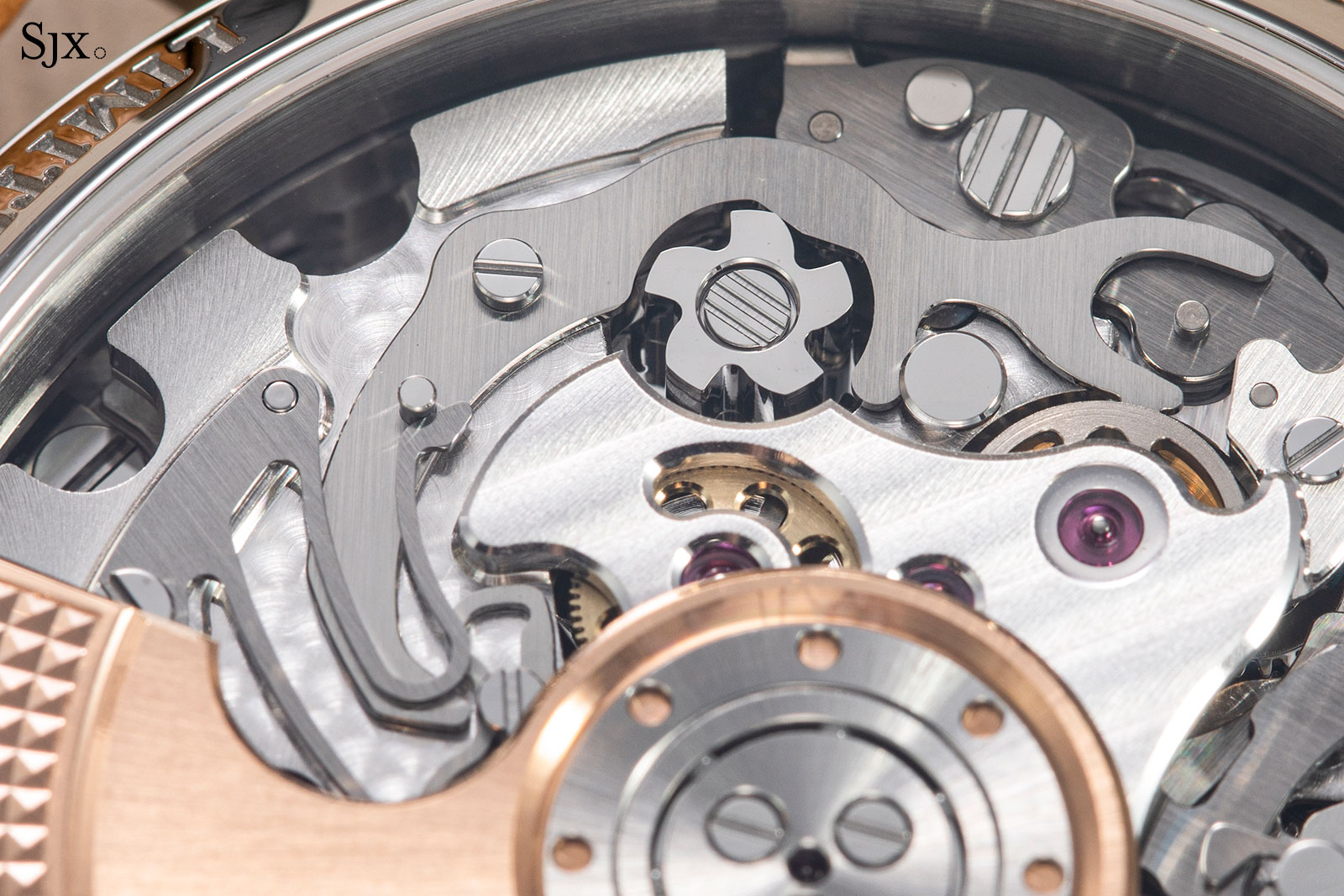
The five-toothed column wheel
The aesthetics of the movement are clearly contemporary – so it is incongruous with the style of the watch – but it is still an attractive movement in a modern, mechanical-looking sense.
A good deal of the chronograph mechanism is exposed, with the levers and springs arranged around the automatic winding bridge. The chronograph mechanism is also more visually complex than the average chronograph, with the levers and springs being more numerous and more dense, a result of its construction (like the individual reset hammers), and the fact that it is a flyback.
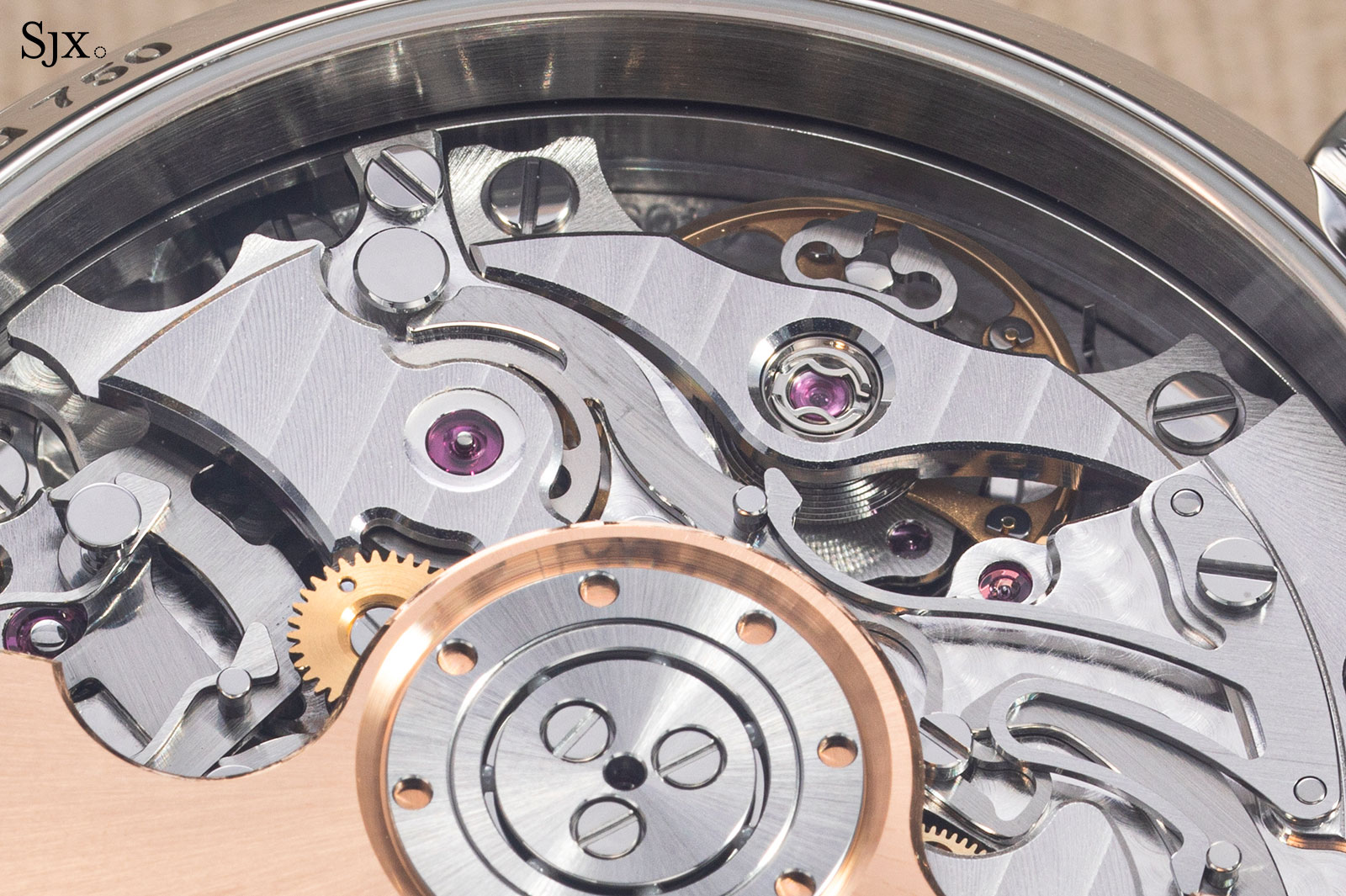
Note the numerous tension springs for the chronograph
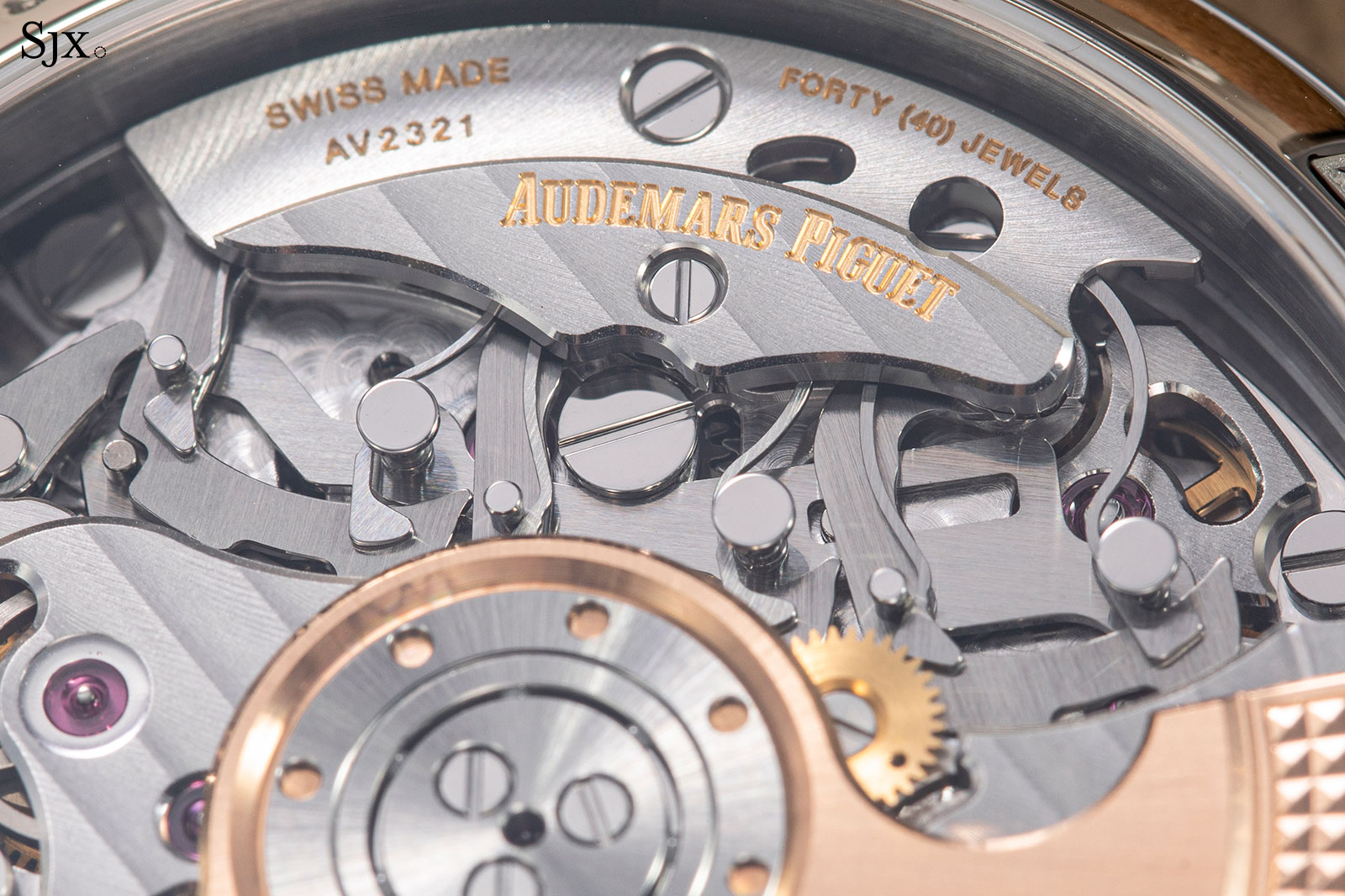
And more springs
The decoration of the movement is extensively and detailed. Every component is carefully finished, even the parts that are barely visible, like the bridge for the pallet lever that sits under the balance wheel. The main bridge, for example, is finished with a variety of treatments, including perlage, anglage, and solarisation.
And wheels that are almost entirely hidden are finished with circular graining on their faces, as well as chamfered inner edges and spokes. The edges and slots of all the screws are similar chamfered.
At the same time, the finishing is typical for AP and other high-end, establishment brands (excepting A. Lange & Söhne), which means it is a mix of machine- and hand-applied finishing. All of the bevelling on the bridges and levers, for instance is done with a milling machine, hence the telltale machining marks on the surfaces of the bevels.
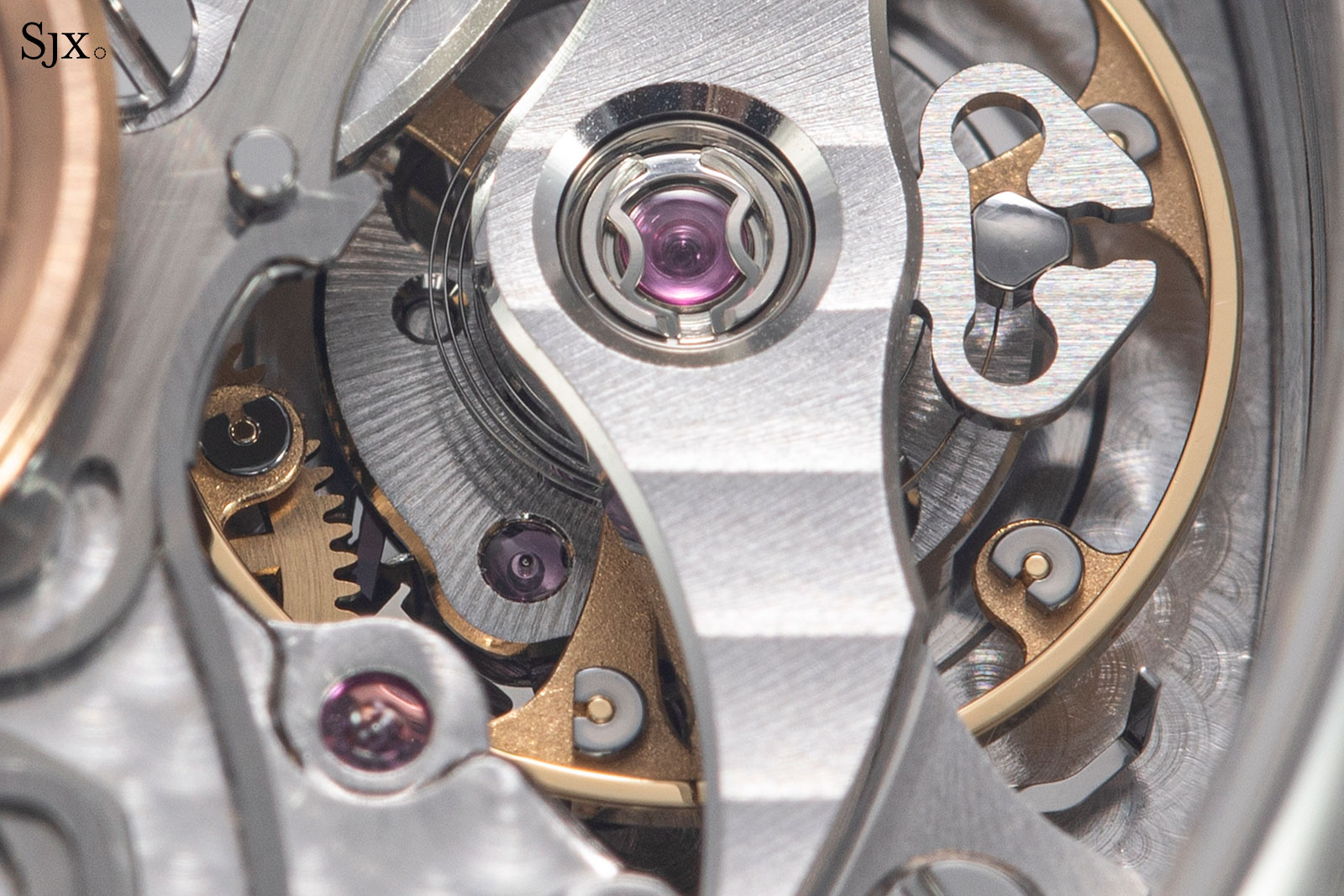
The pallet lever bridge is finished with radial graining, as well as bevelled edges and countersinks
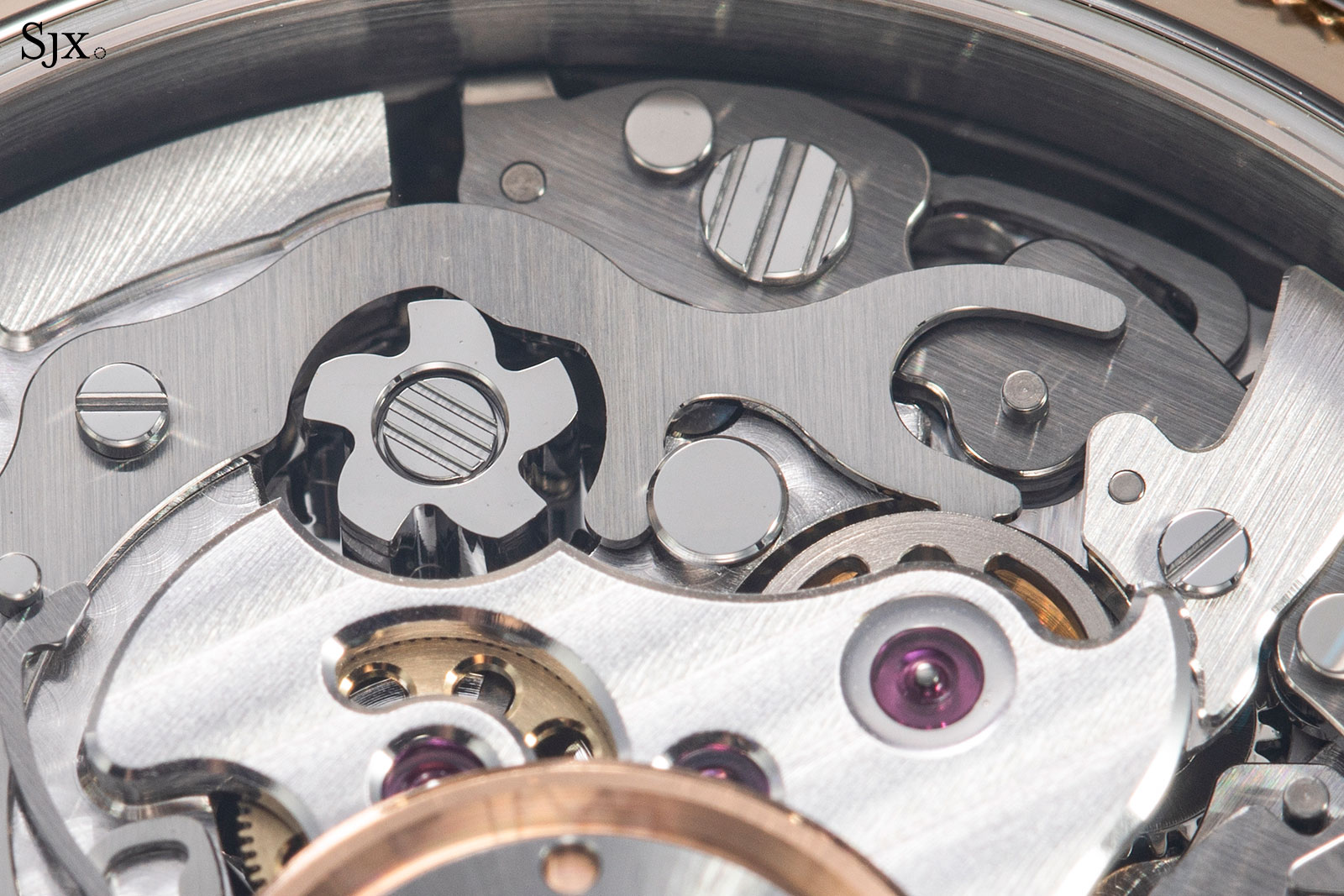
Notice the bevelled edges and slots on all the screws
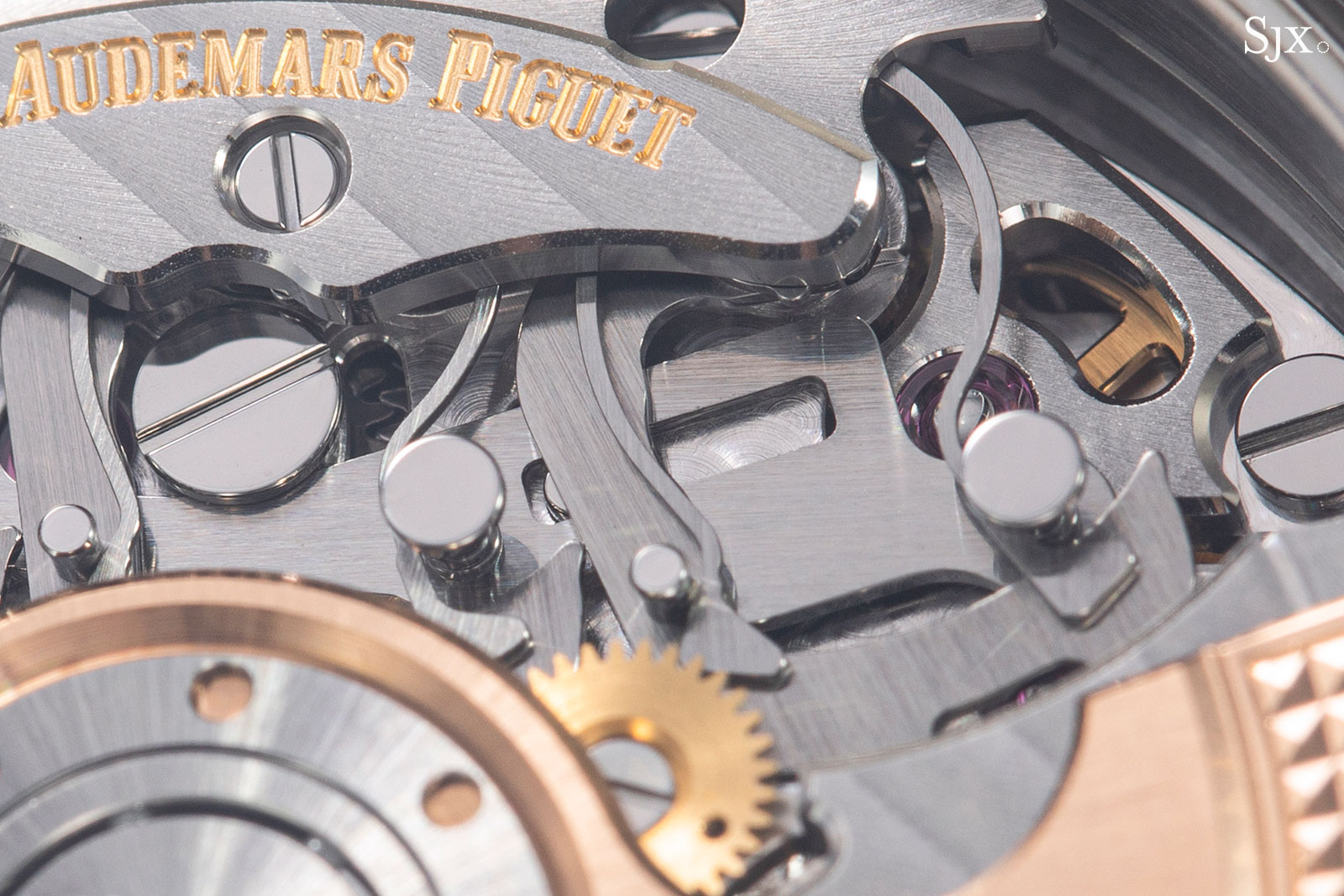
Every component, even ones hidden underneath, is finished properly
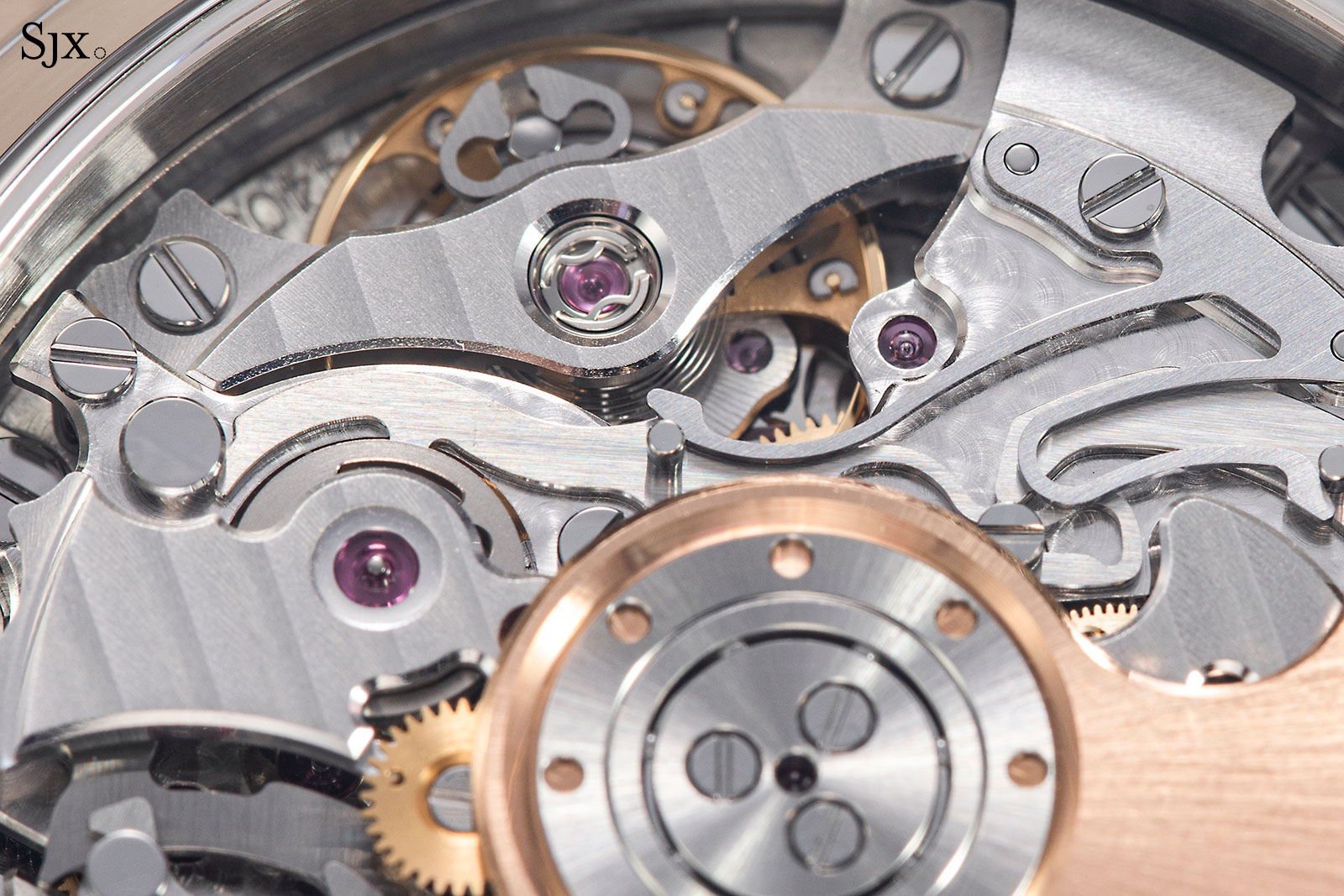
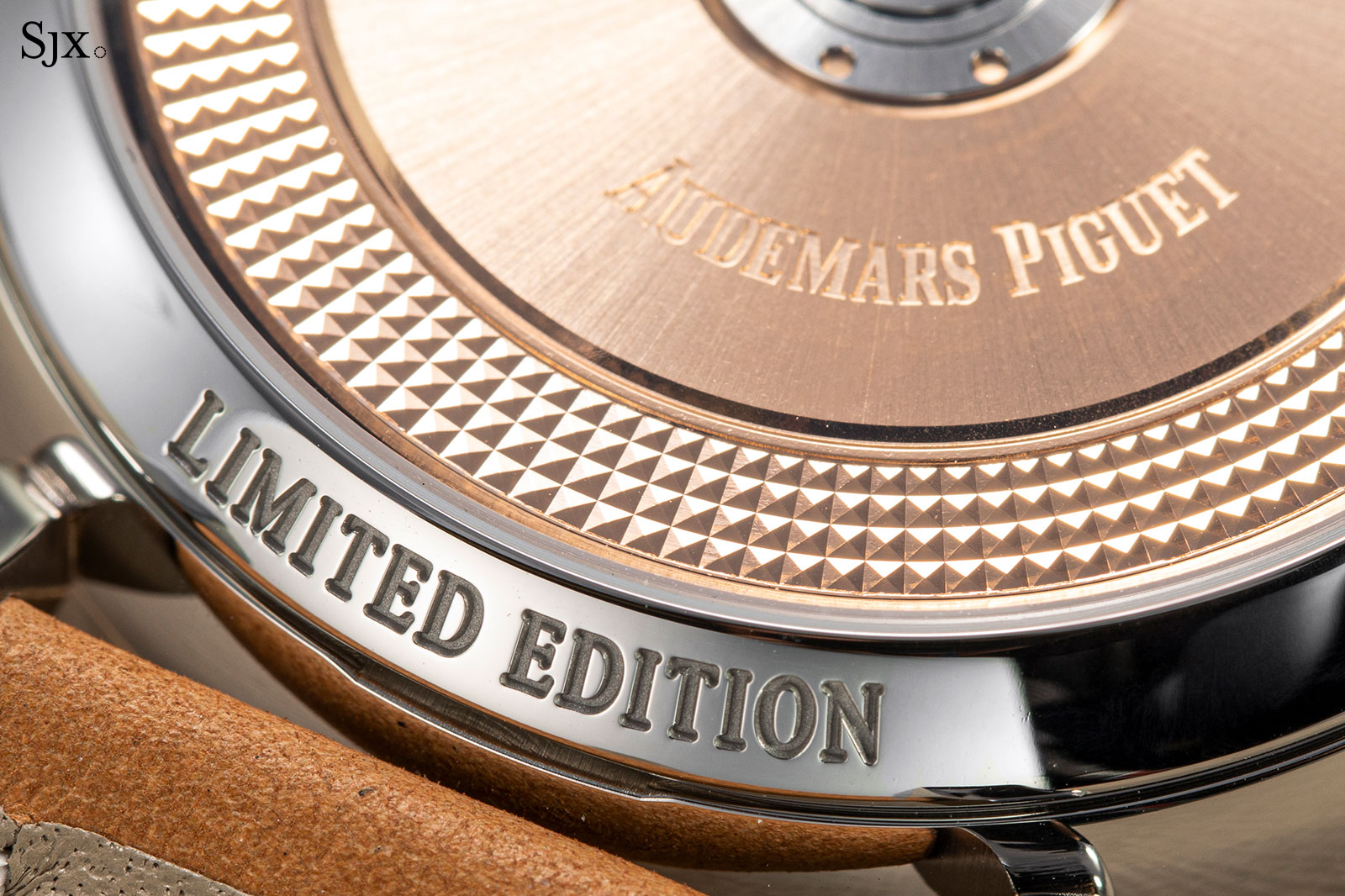
Another example of attention to detail: “Limited Edition” on the case back is in a serif font, a smart choice that matches the typography on the dial
One element of the movement that is clearly old-fashioned in decoration is the clous de Paris pattern on the rotor that is engraved the traditional way, with a hand-operated rose engine.
While it is beautifully decorated – the guilloche is sharp defined and every pyramid has a clearly pointed tip – the rotor looks massive. The rotor is solid 22k gold but there is too much of it, so one can have too much of a good thing.
In comparison, the rotor used on the cal. 4401 in the Code 11.59 is skeletonised, leaving much more of the movement visible.
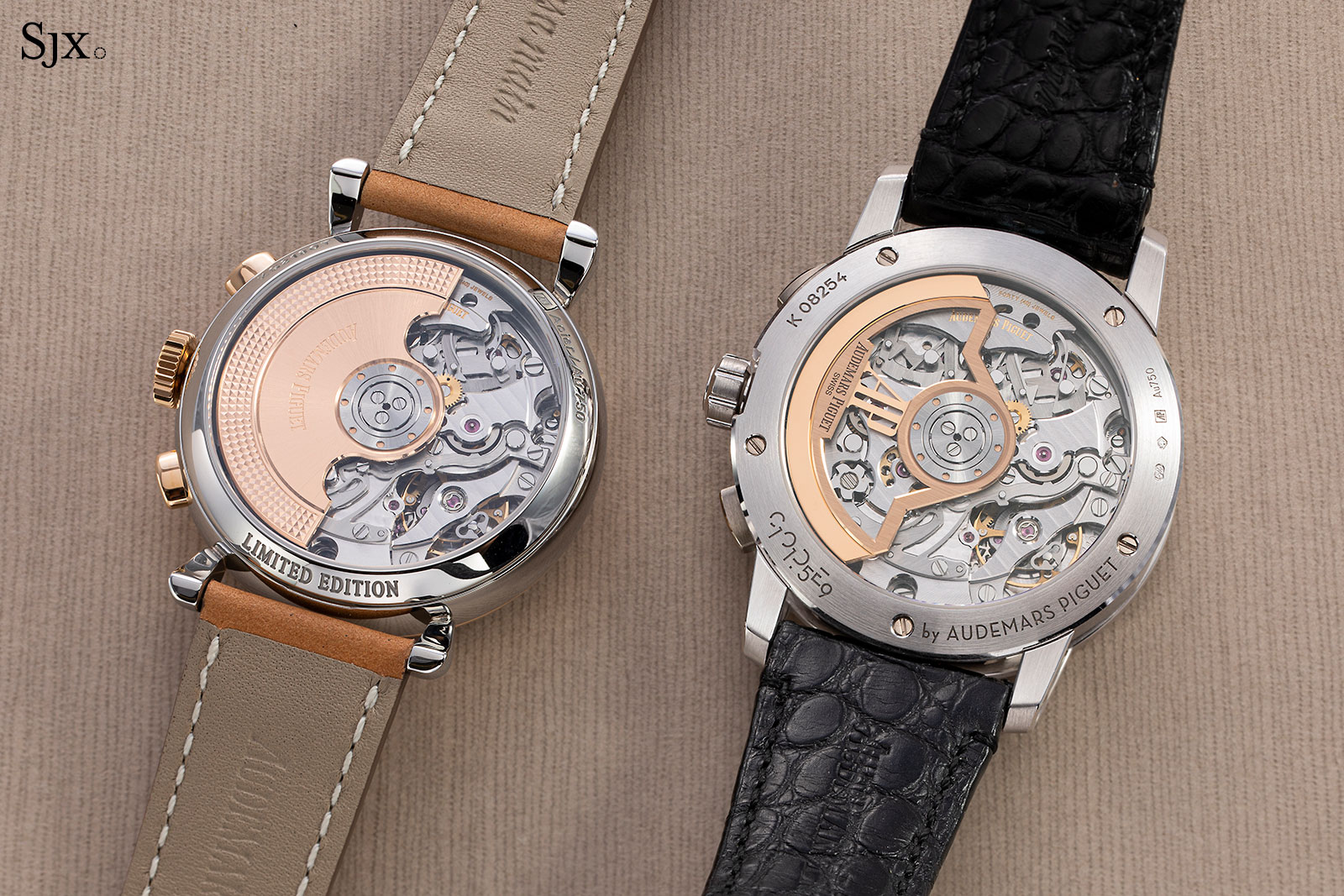
Concluding thoughts
The [Re]master01 is a beautifully executed watch that is good looking and also high quality, inside and out. Though the case is thick, the other qualities of the watch make up for it.
The attention to detail, especially on the dial, is tremendous. Very few vintage remakes, or remasters, exhibit the same refinement in the smallest of details, like the serifs on the hour markers. And while the movement is more modern the the dial suggest, the construction of the movement is top class, and the finishing is as good as one finds on comparable watches.
But the retail price is high and difficult to stomach. At US$53,100, the [Re]master01 with its steel-and-gold case is more expensive than the Code 11.59 chronograph that’s entirely in 18k pink gold and retails for US$42,400.
Though the watch is a limited edition, it is a 500-piece run, which is a generous number as such things go. That doesn’t help the high price much either.
Surprisingly – and in contrast to the usual long wait between launch and availability – the watch is already at boutiques (that remain open) and will be available starting March 30, 2020.
Key facts and price
Audemars Piguet [Re]master01 Selfwinding Chronograph 40 mm
Ref. 26595SR.OO.A032VE.01
Case diameter: 40 mm
Case height: 14.6 mm
Material: Steel and 18k pink gold
Water resistance: 20 m
Movement: Cal. 4409
Functions: Time, and flyback chronograph
Frequency: 28,800 beats per hour (4 Hz)
Winding: Automatic
Power reserve: 70 hours
Strap: Brown calfskin with pin buckle; additional brown alligator strap
Limited edition: 500 pieces
Availability: Only at Audemars Piguet boutiques starting March 30, 2020
Price: US$53,100; or 74,400 Singapore dollars
For more, visit Audemarspiguet.com.
Back to top.

